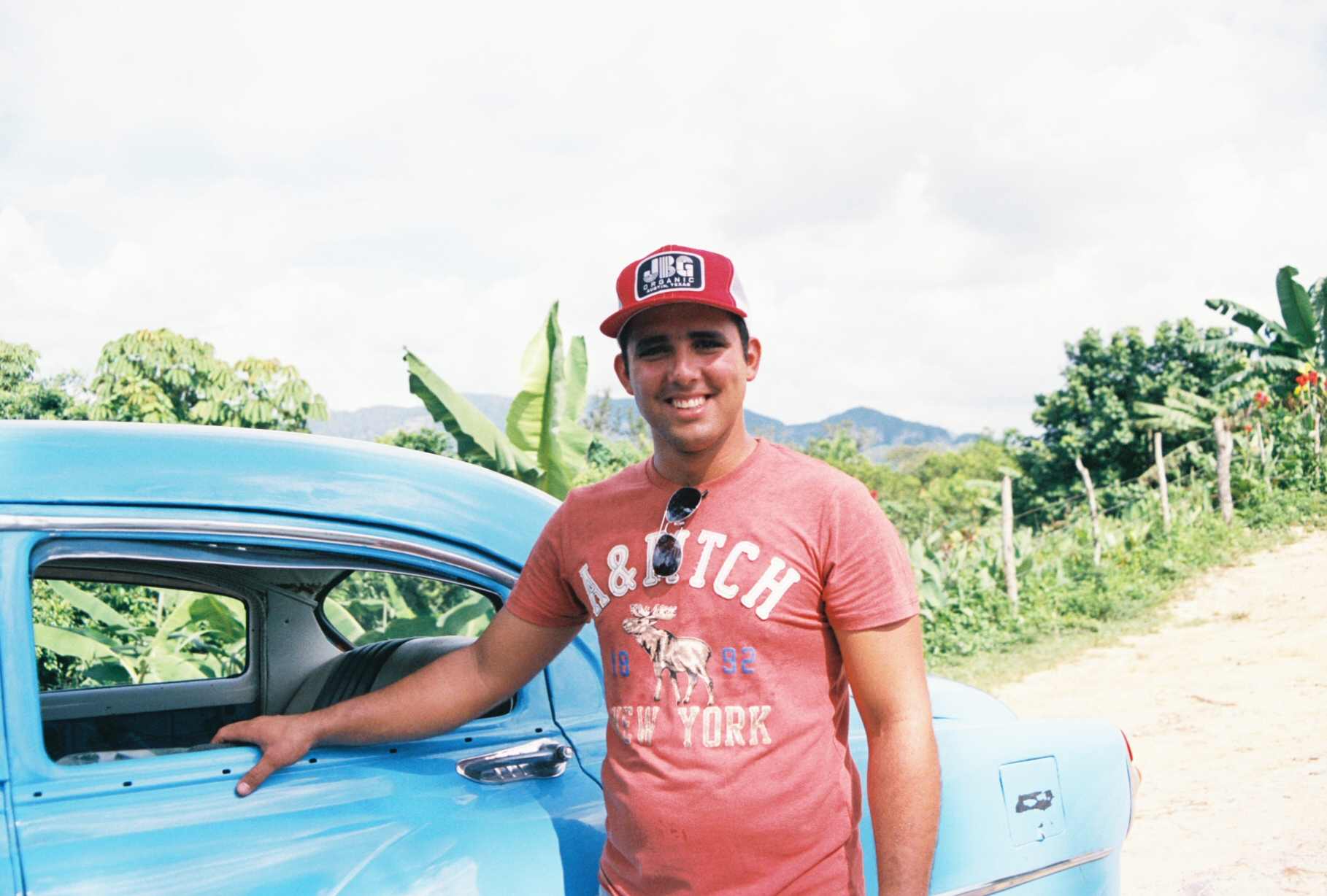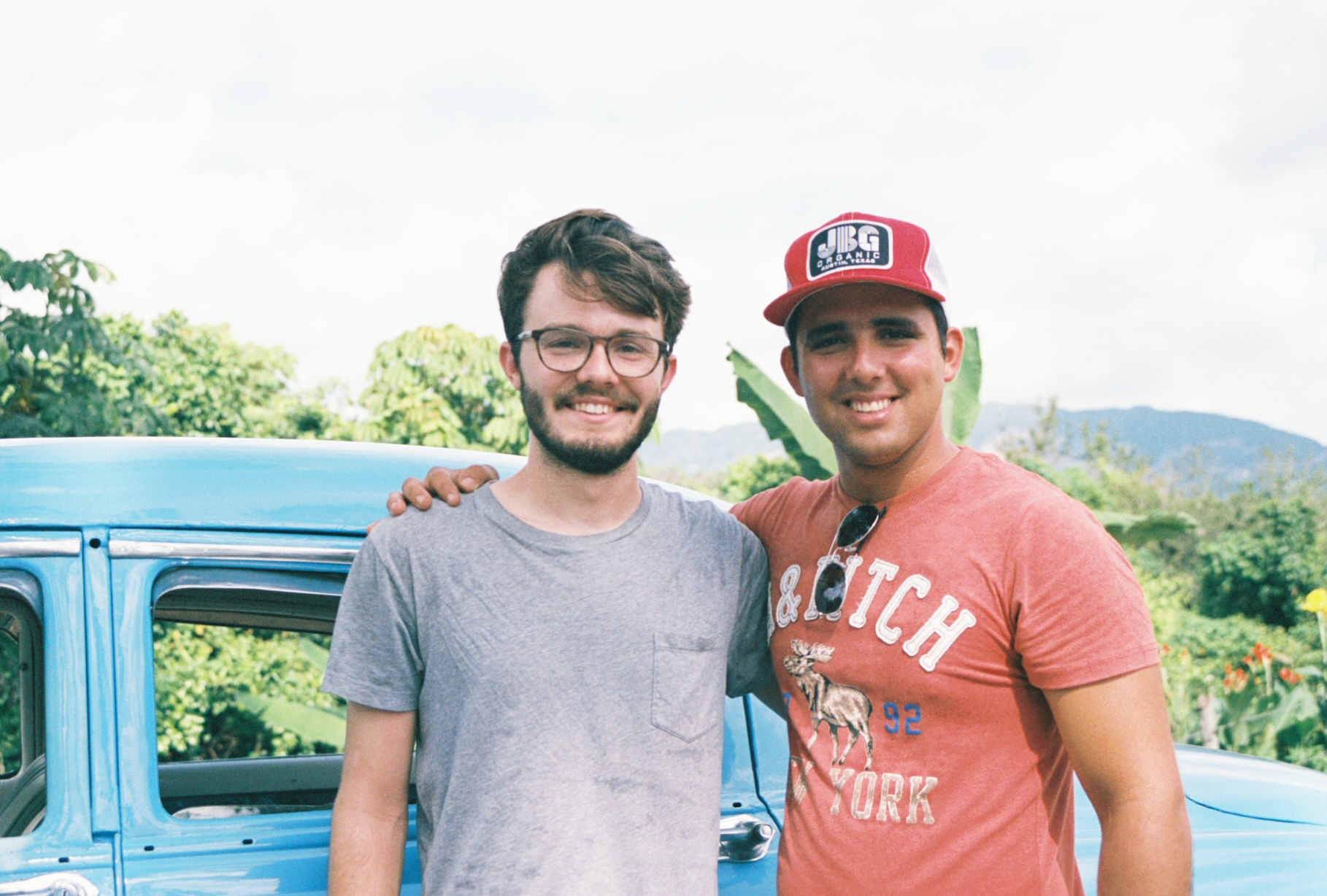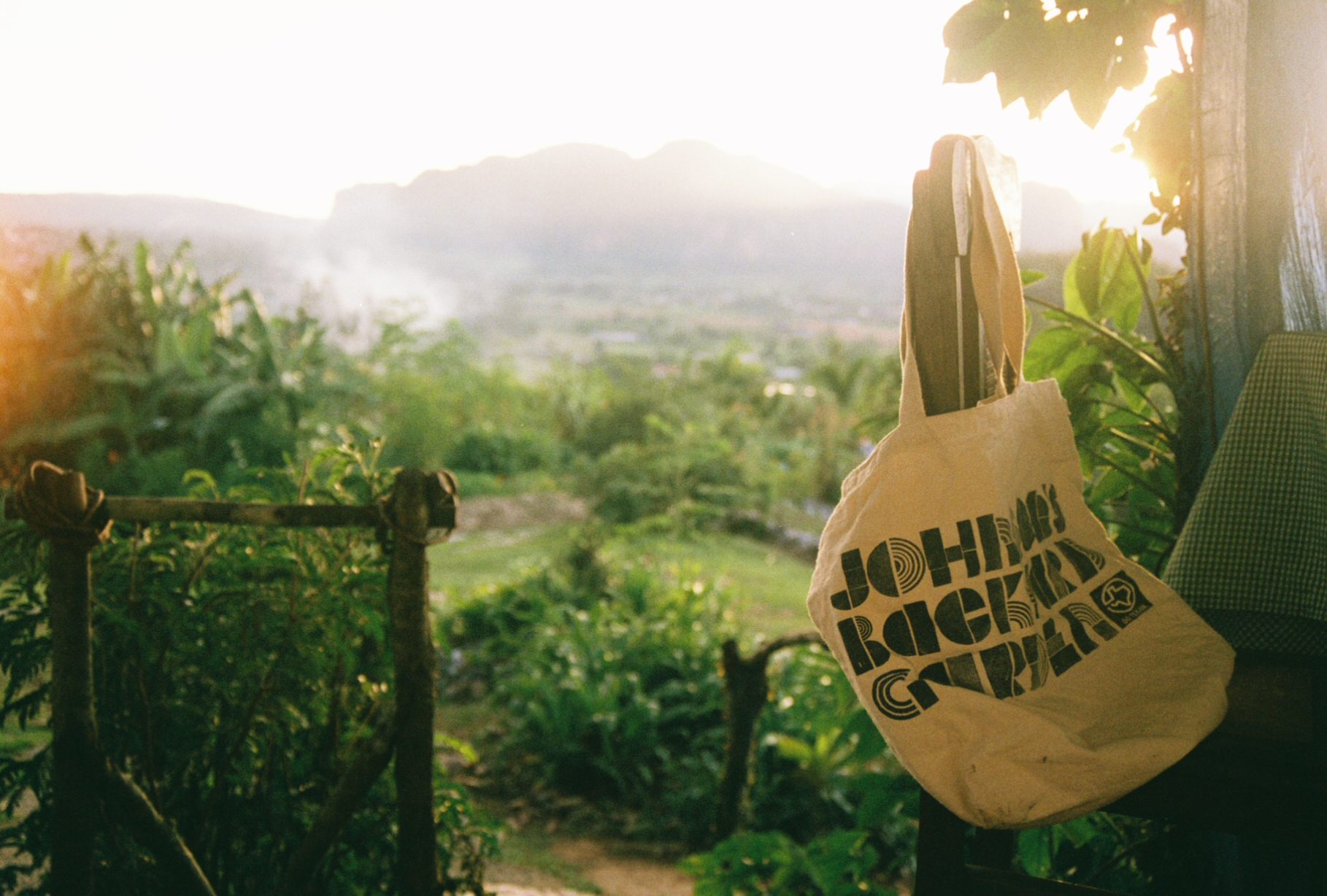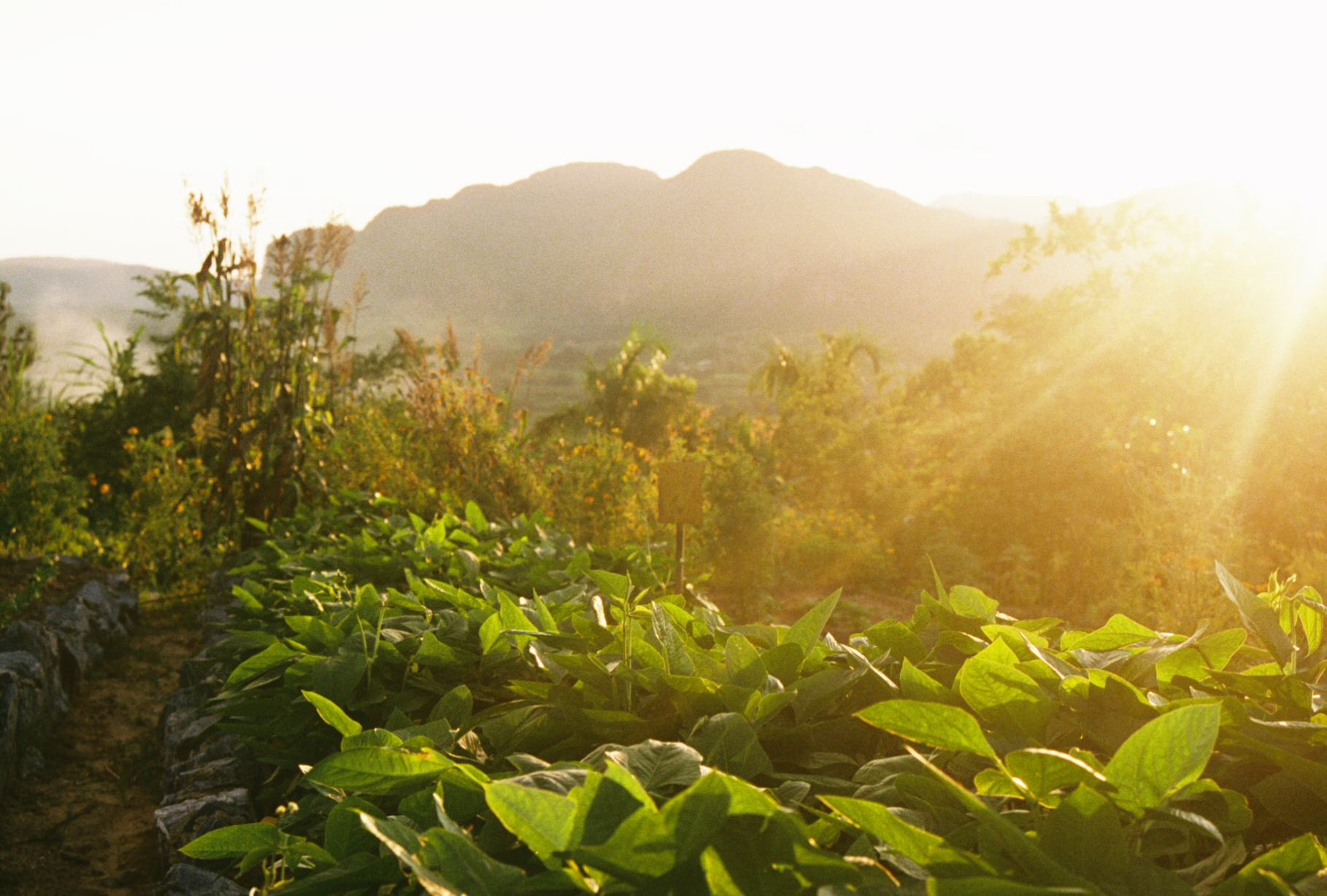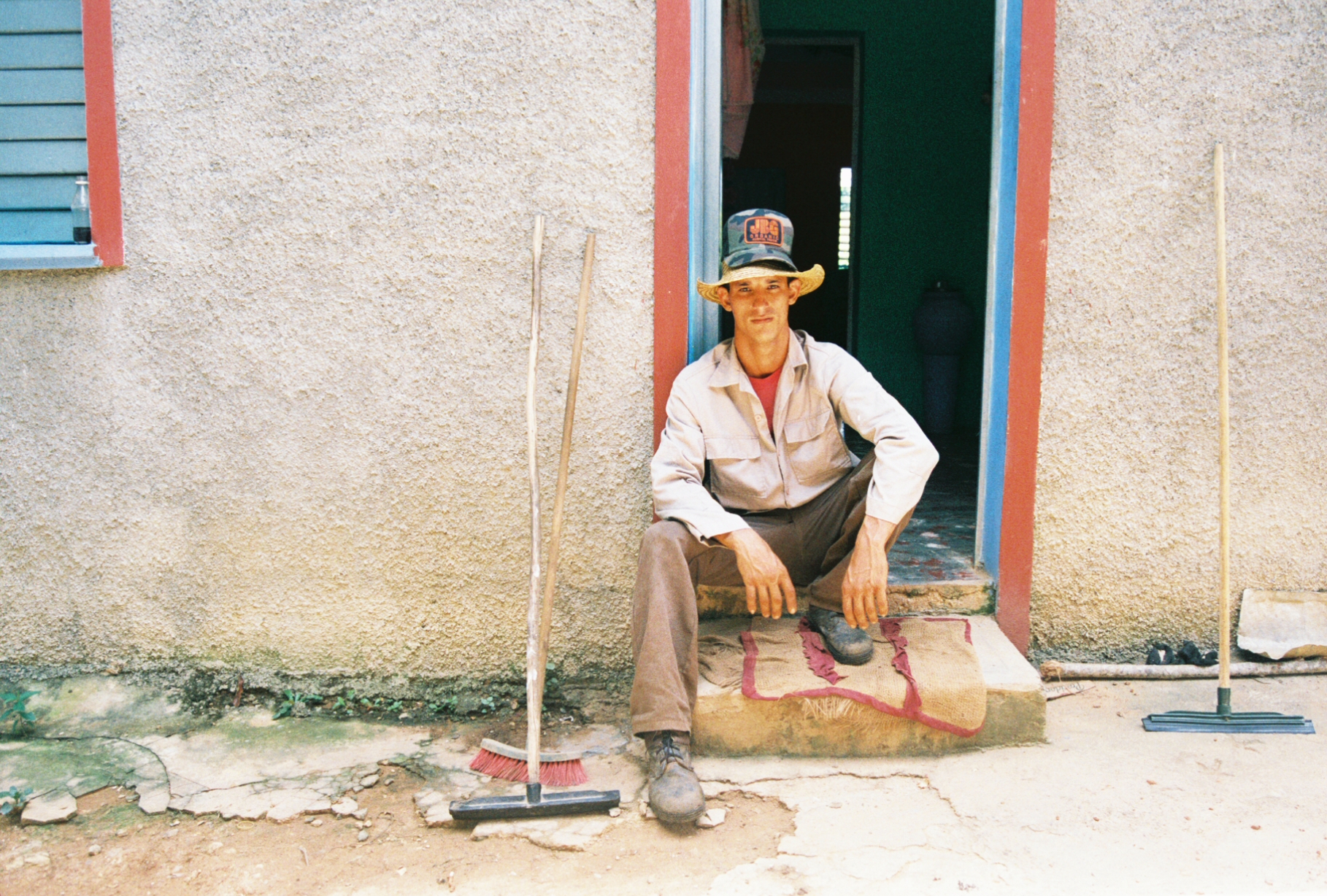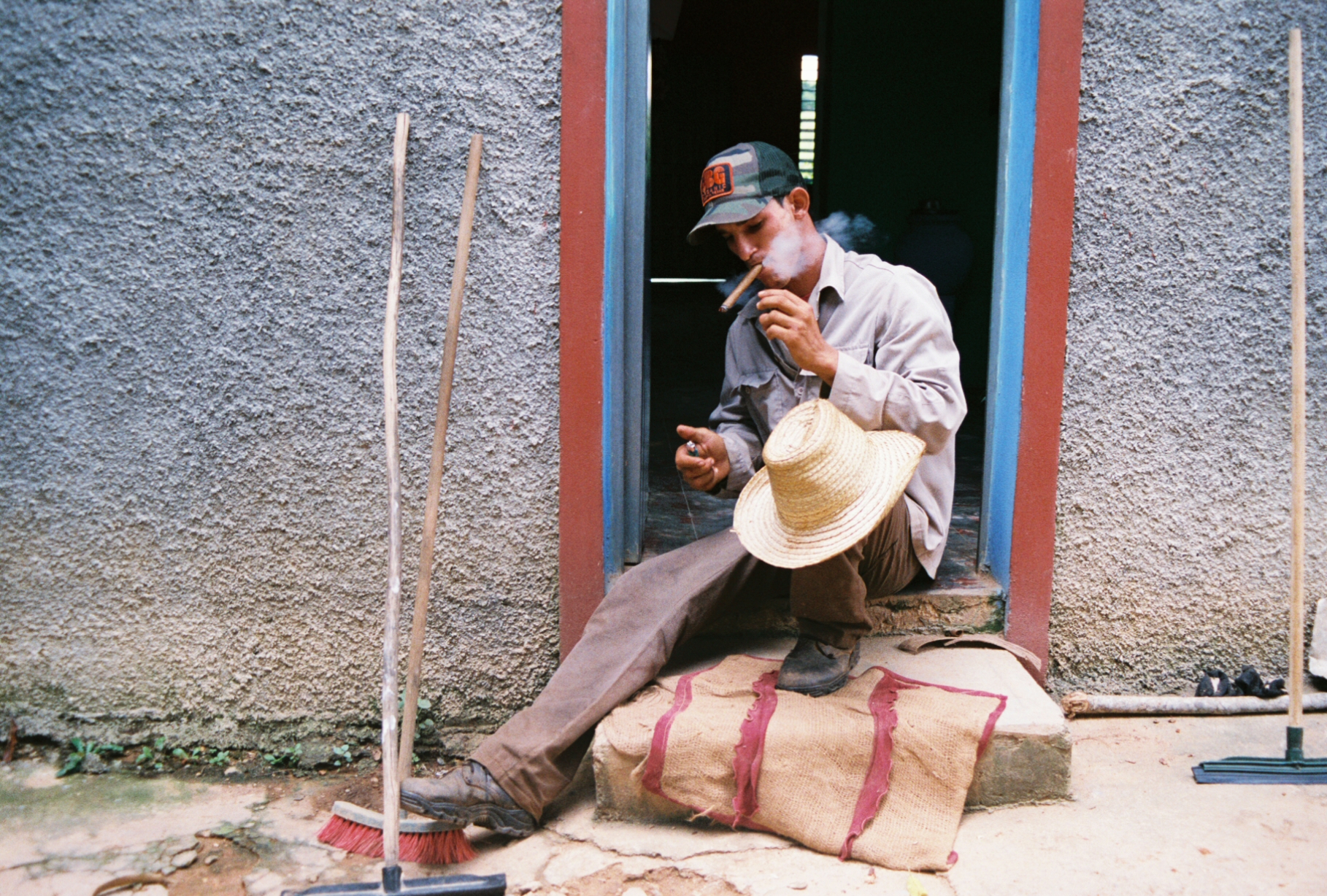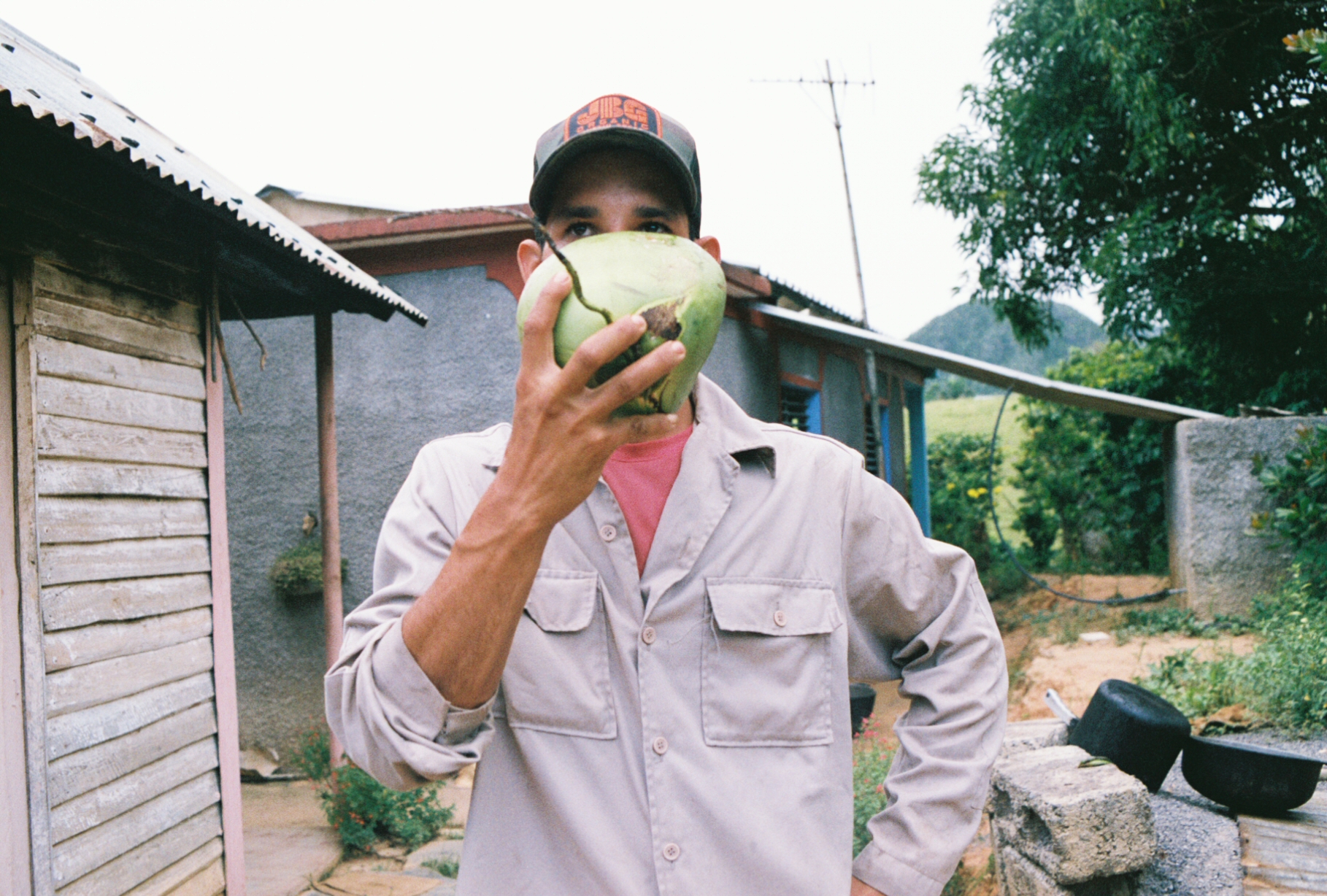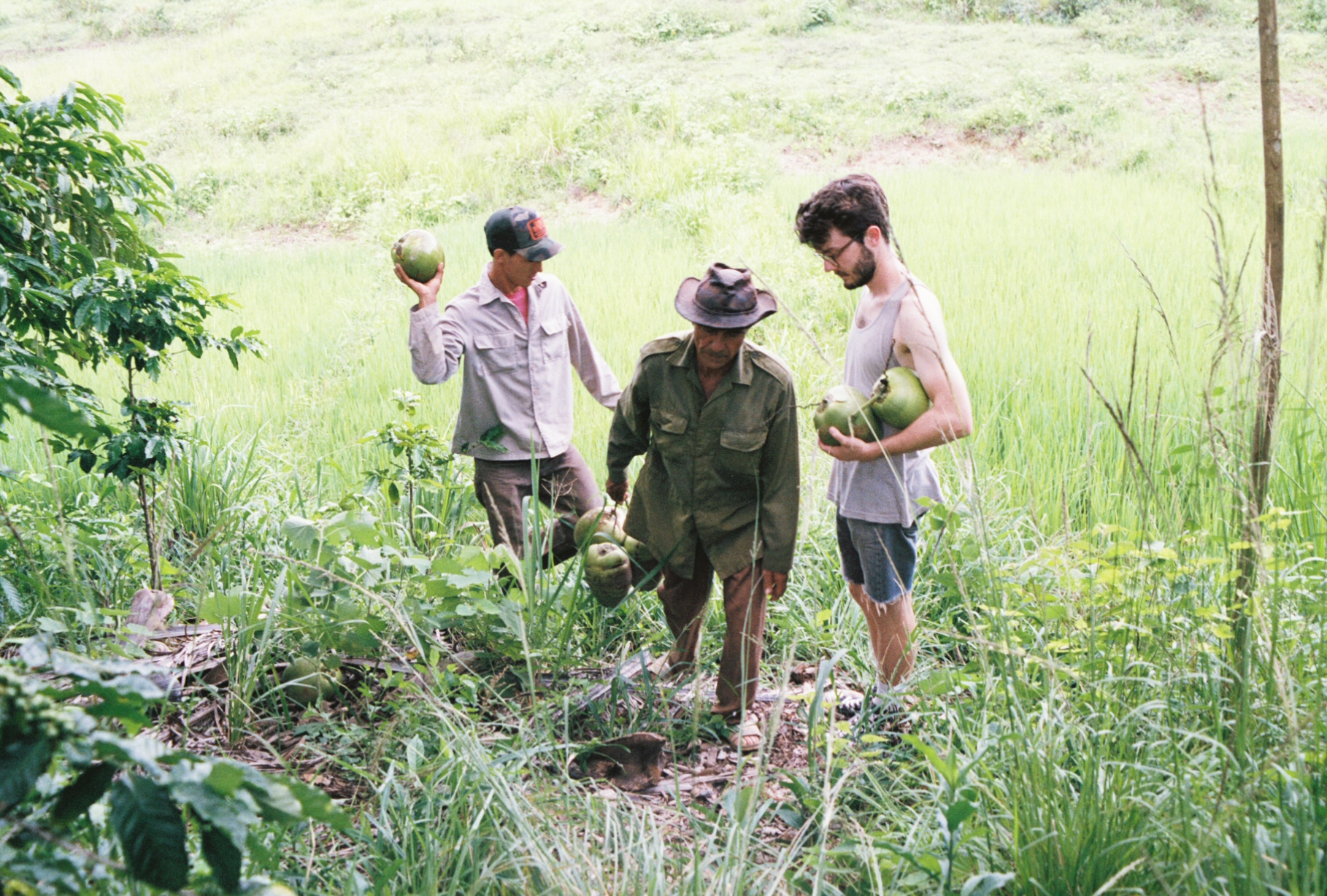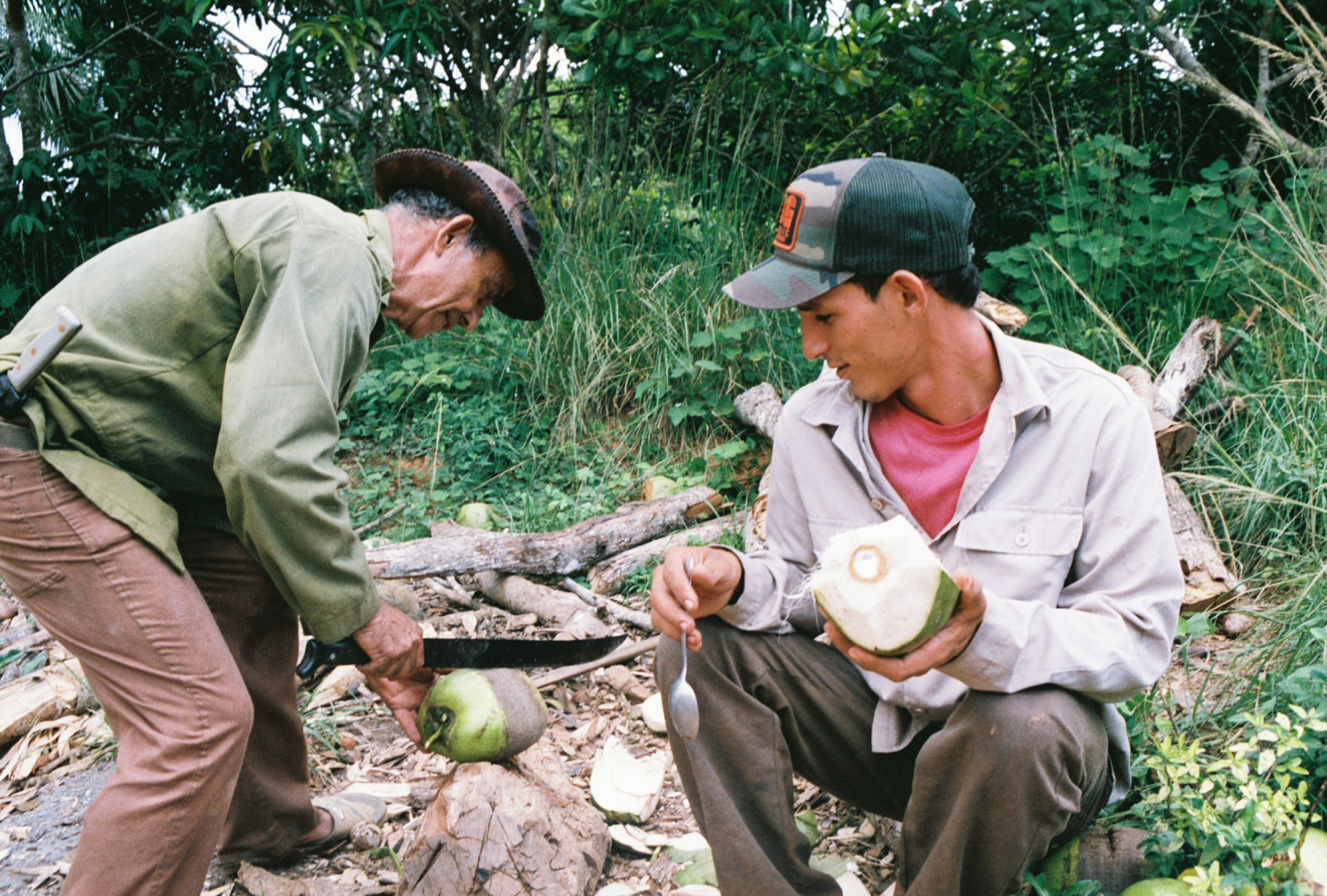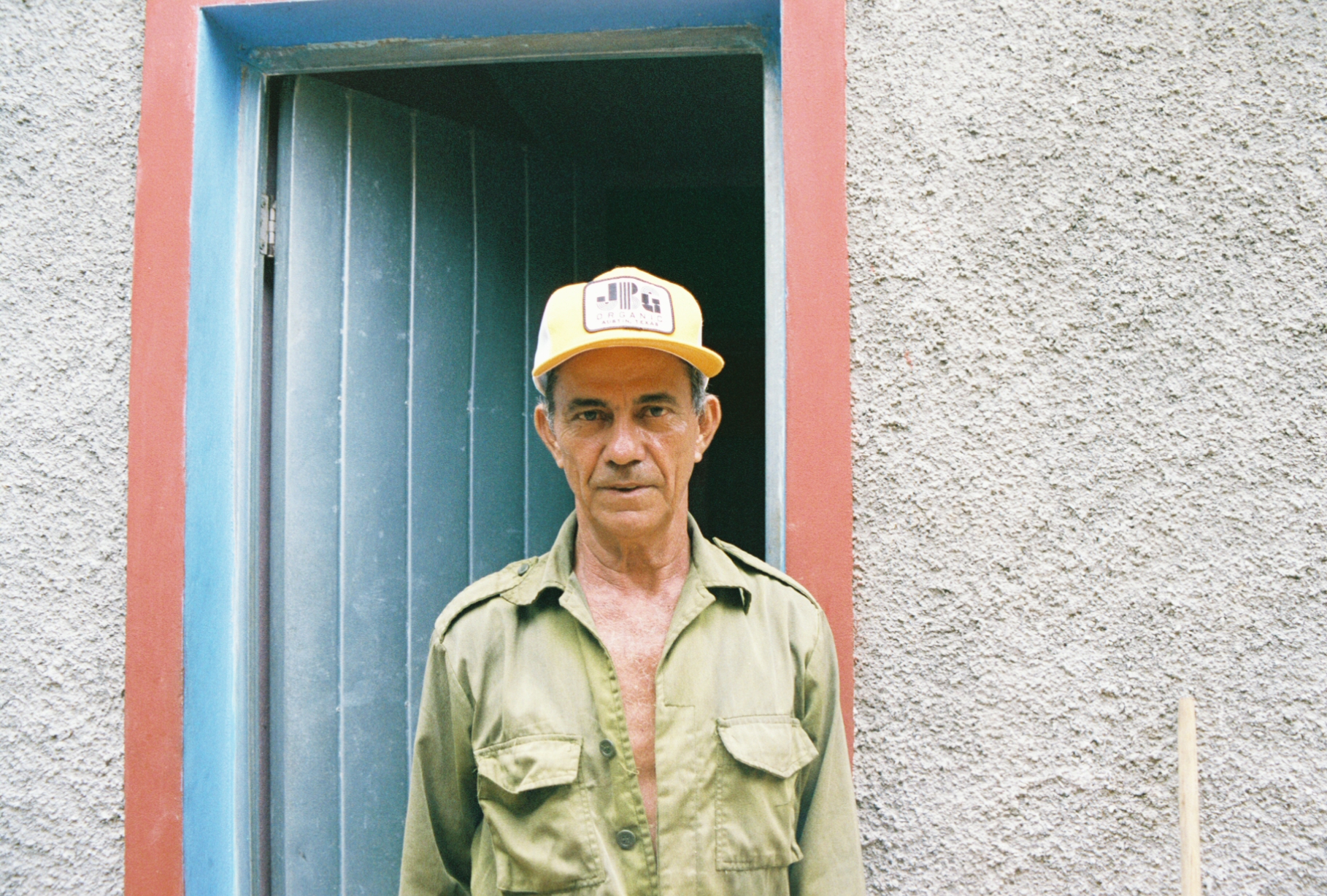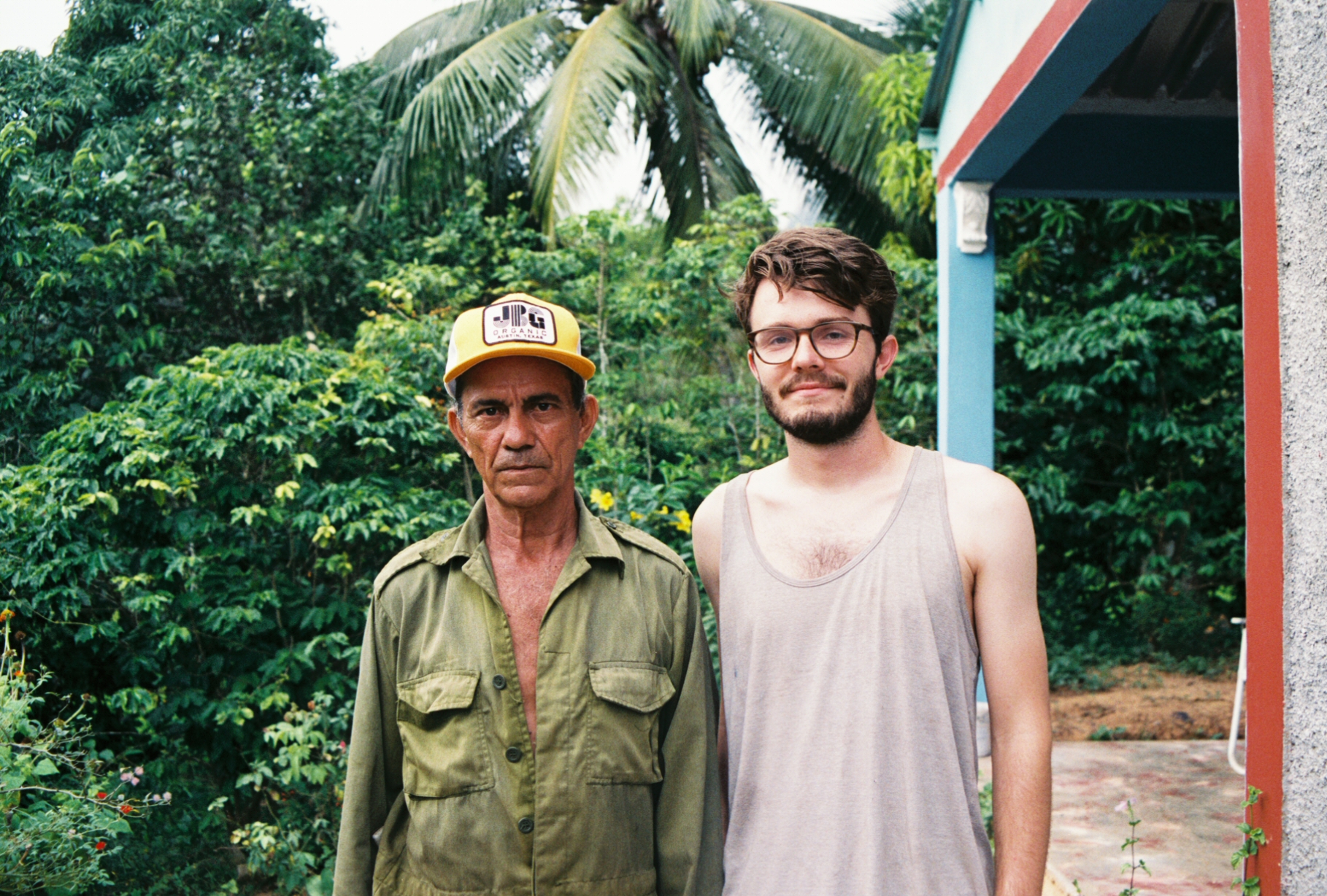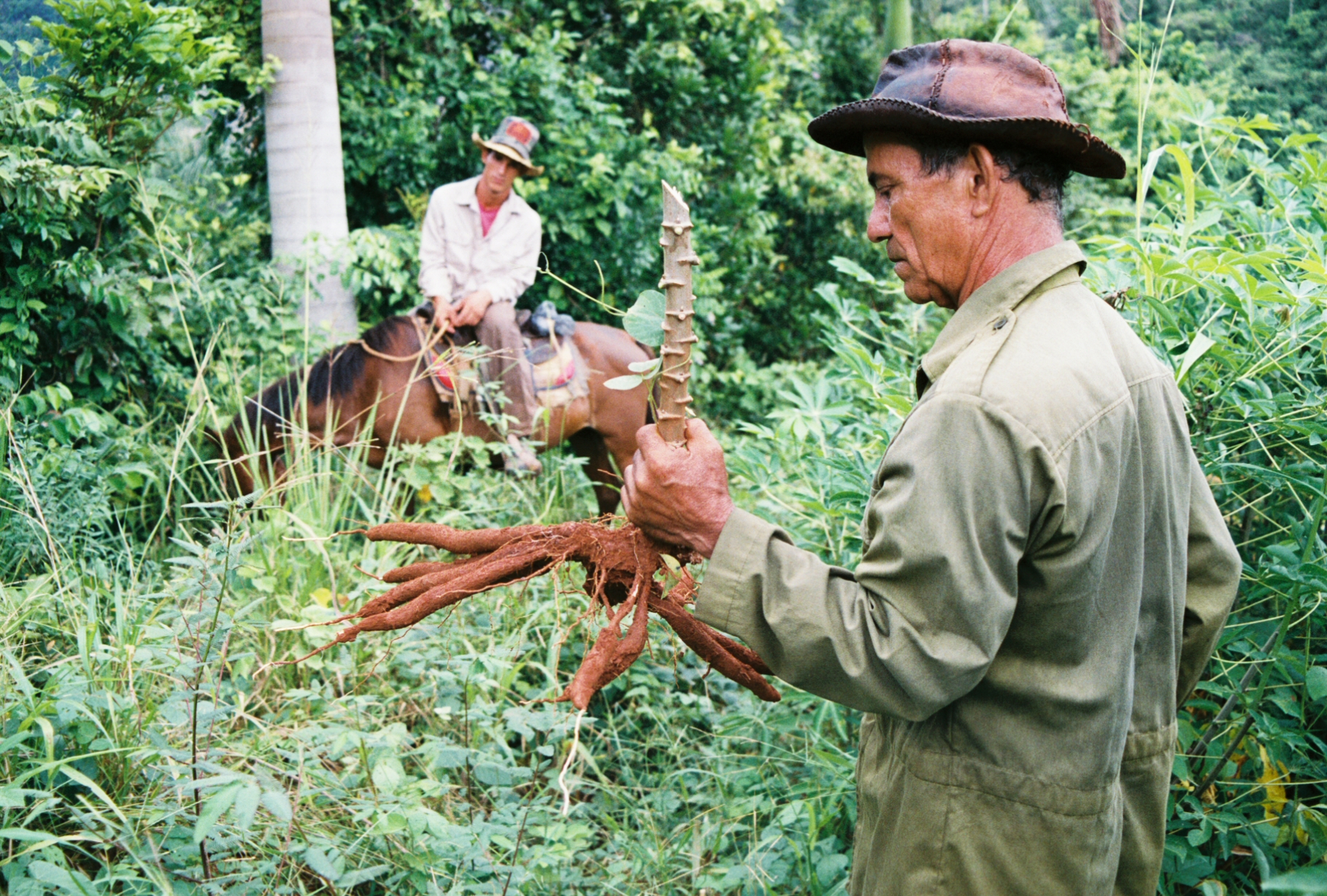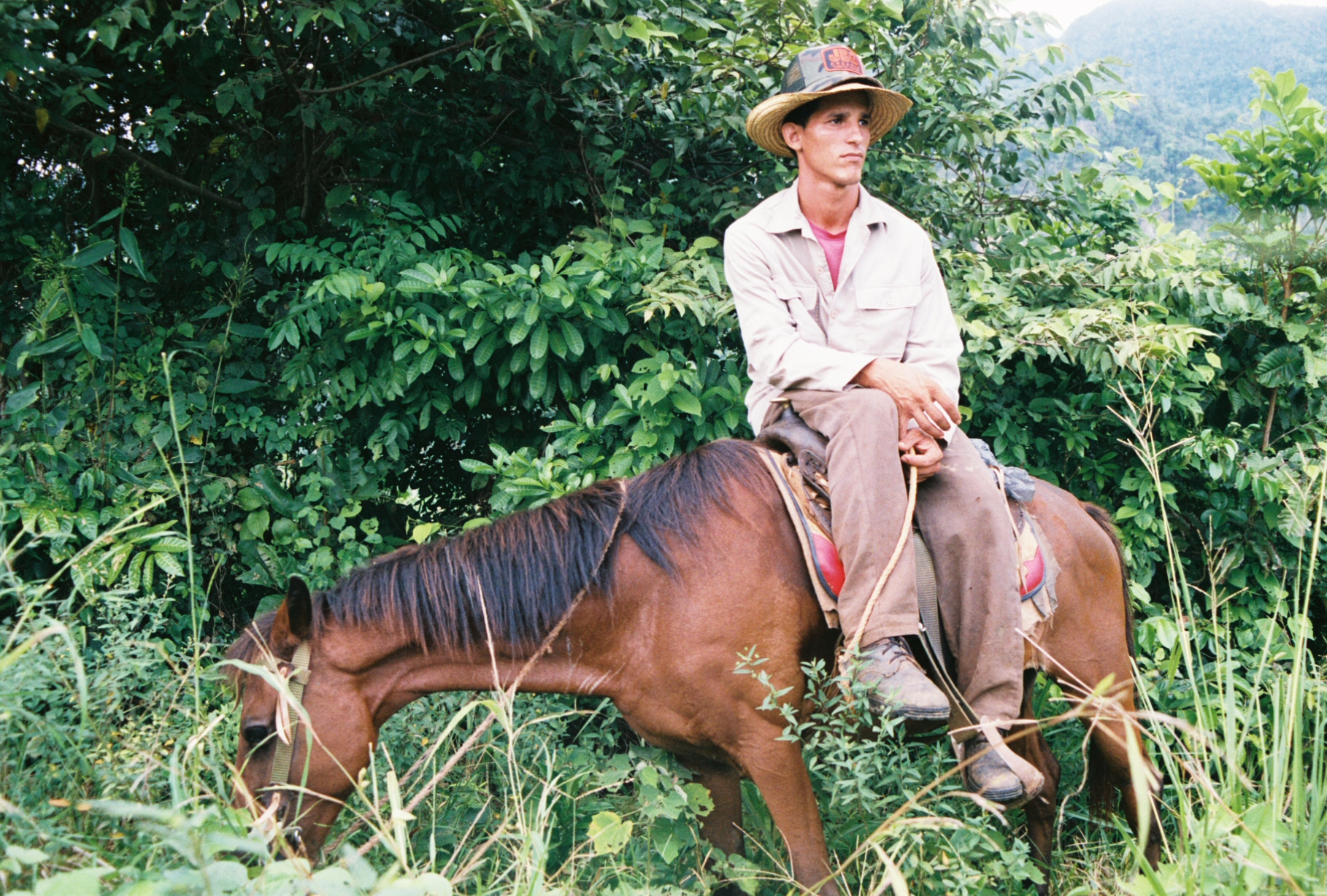
COLD SOBA NOODLES WITH CRISP VEGGIES
09/01/15 — Farm
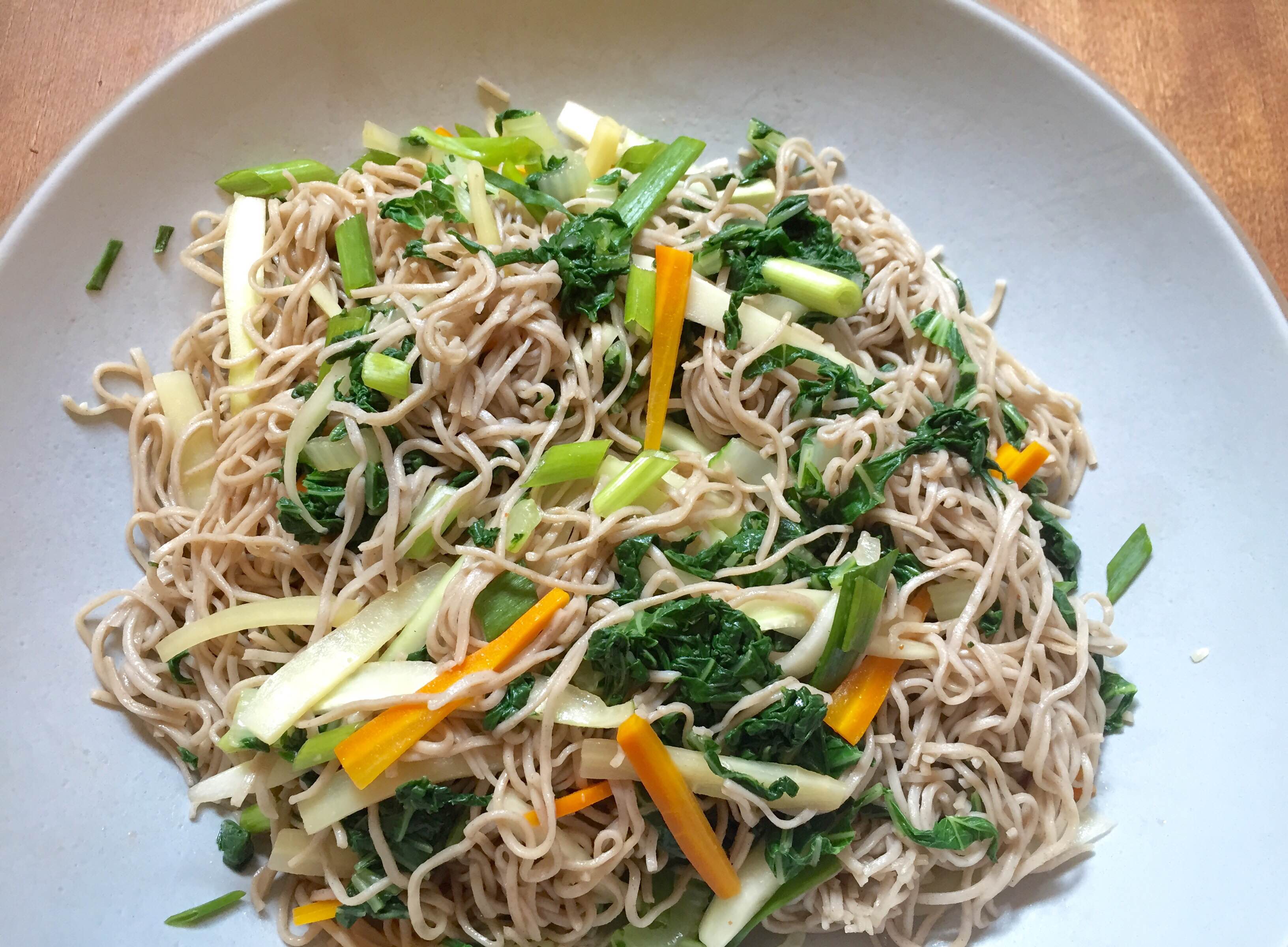
By Megan Winfrey
There was an exciting new addition to my CSA box this week - BOK CHOY! I've been trying to dabble more in Asian cooking lately (I made Chicken Tom Kha last week, so good) and knew I wanted to make a cold noodle dish. Nothing is more refreshing than crisp veggies & cold noodles with a tangy vinegar dressing. And talk about awesome leftovers. My husband and I have lunch for the next few days!
Cold Soba Noodles with Crisp Veggies
- 3 carrots, peeled and julienned,
- 1 cucumber, peeled, seeded and julienned,
- 1-2 heads of bok choy, cut into ribbons,
- 1 package of dried soba noodles (usually 1/2 lb.),
- 6 scallions, thinly sliced,
- 2 tbs. toasted sesame seed oil,
- 4 tbs. rice vinegar,
- 2 tbs. soy sauce,
- 1 tsp. hot sauce
Let the water come back up to a boil. Drop in the bok choy and blanch for 30 seconds, then remove with a strainer. Run under cold water, press out the water a bit, and add to the carrots.
Let the water come back up to a boil. Cook the soba noodles per the package instructions, usually 5-8 minutes for al dente. Strain the noodles, let cool, and add to the carrots and bok choy.
Add the scallions and cucumbers and gently toss everything together.
Whisk together the toasted sesame seed oil, rice vinegar, hot sauce, and soy sauce. Pour over the noodles and vegetables and toss until everything is coated.
This pasta can be served warm, if preferred, and can be refrigerated for up to 3
WEEK 36 IN PHOTOS
09/04/15 — Farm
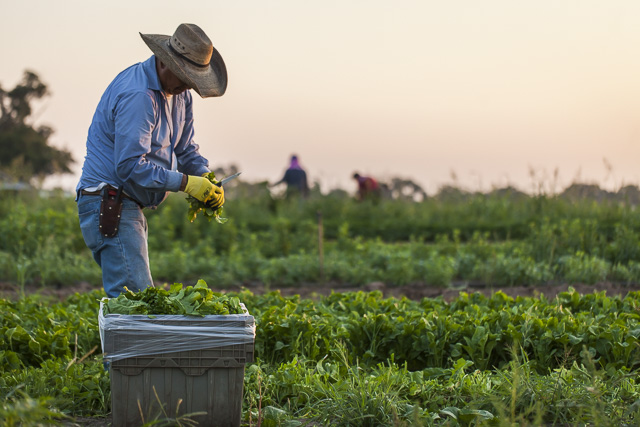 Arugula is coming in strong. Photo by Scott David Gordon
Arugula is coming in strong. Photo by Scott David Gordon
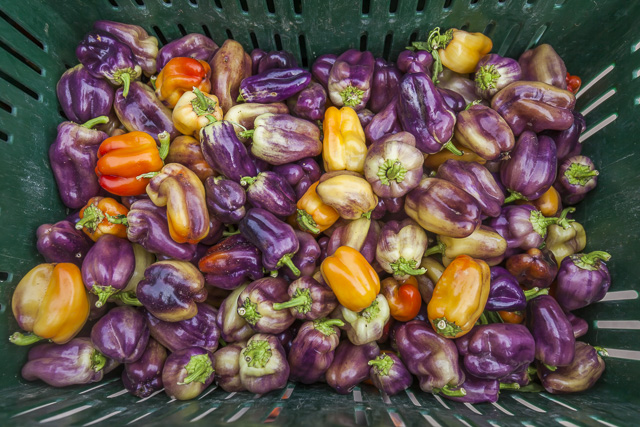 We're loving the colors of these Purple Bell Peppers! Photo by Scott David Gordon
We're loving the colors of these Purple Bell Peppers! Photo by Scott David Gordon
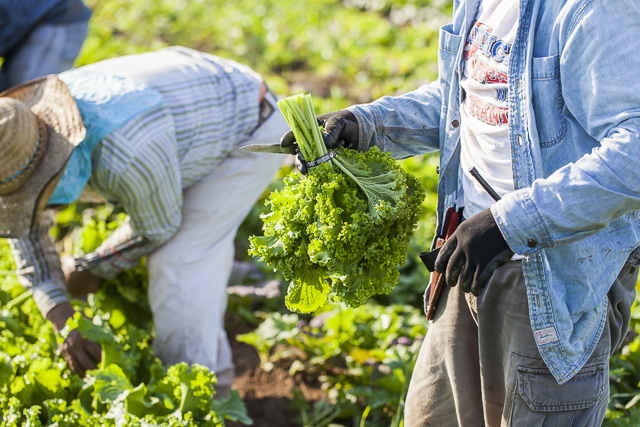 Green Mustard harvest. Photo by Scott David Gordon
Green Mustard harvest. Photo by Scott David Gordon
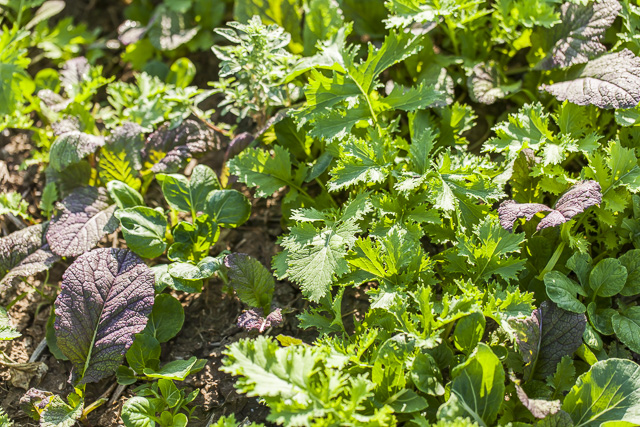 Young braising mix in the field. Photo by Scott David Gordon
Young braising mix in the field. Photo by Scott David Gordon
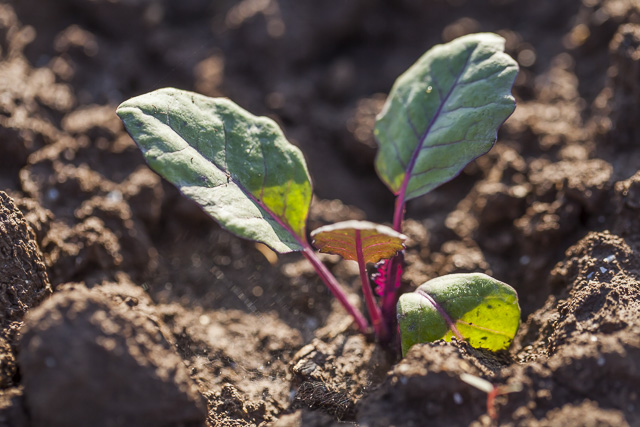 A newly transplanted Red Cabbage. Photo by Scott David Gordon
A newly transplanted Red Cabbage. Photo by Scott David Gordon
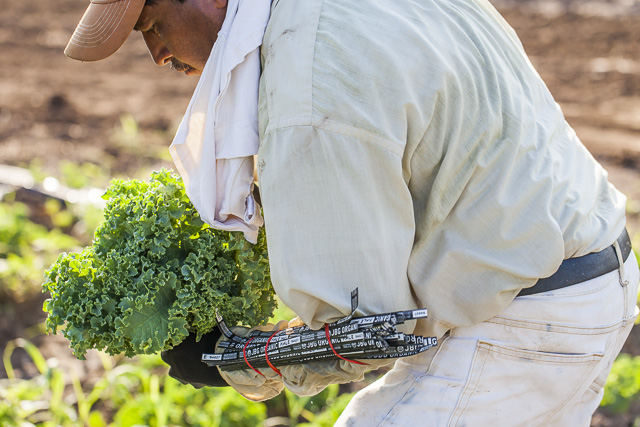 Kale harvest. Photo by Scott David Gordon
Kale harvest. Photo by Scott David Gordon
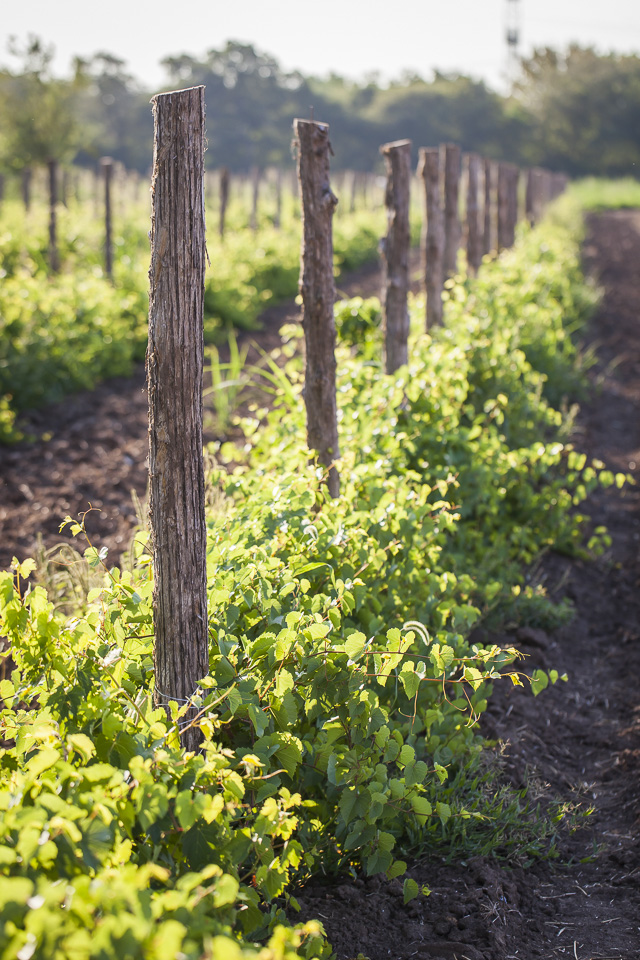 Our newly planted vineyard in the morning light. Photo by Scott David Gordon
Our newly planted vineyard in the morning light. Photo by Scott David Gordon
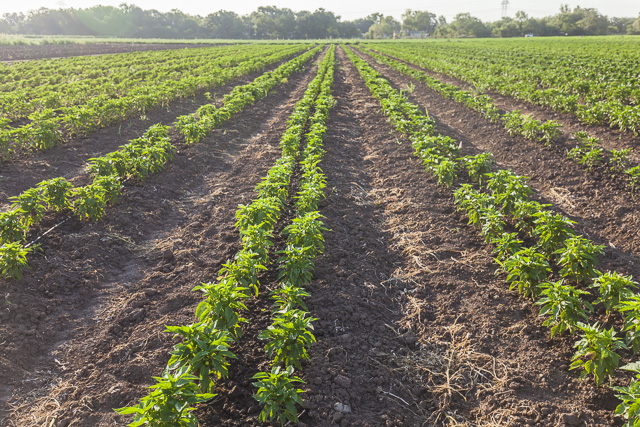 Field of peppers for fall. Photo by Scott David Gordon
Field of peppers for fall. Photo by Scott David Gordon
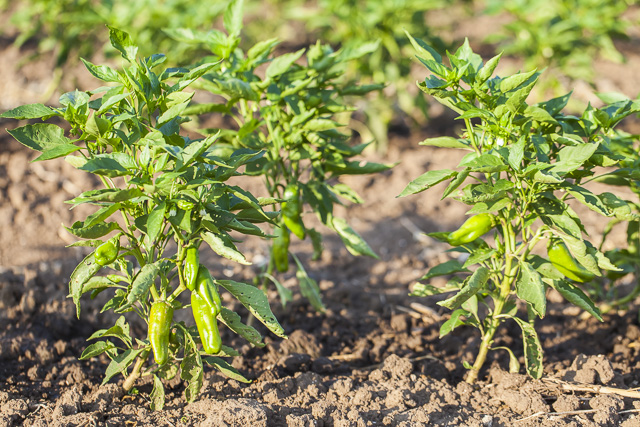 Sweet peppers ripening on the vine. Photo by Scott David Gordon
Sweet peppers ripening on the vine. Photo by Scott David Gordon
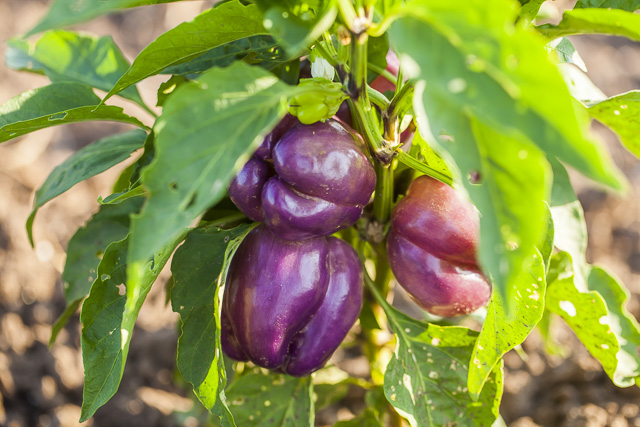 Purple bell peppers. Photo by Scott David Gordon
Purple bell peppers. Photo by Scott David Gordon
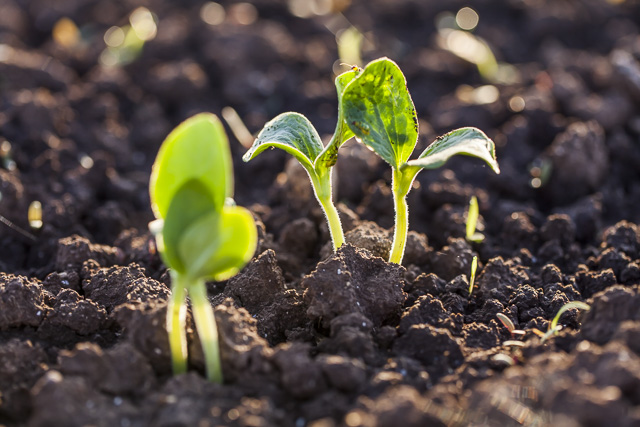 New seedlings will be melons before you know it. Photo by Scott David Gordon
New seedlings will be melons before you know it. Photo by Scott David Gordon
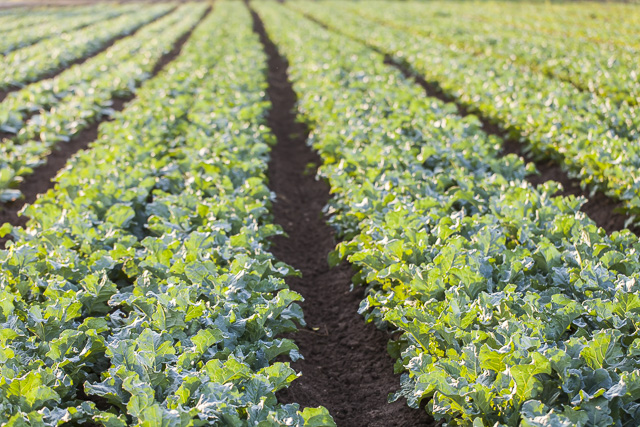 Our first round of Broccoli seems to be doing great. Photo by Scott David Gordon
Our first round of Broccoli seems to be doing great. Photo by Scott David Gordon
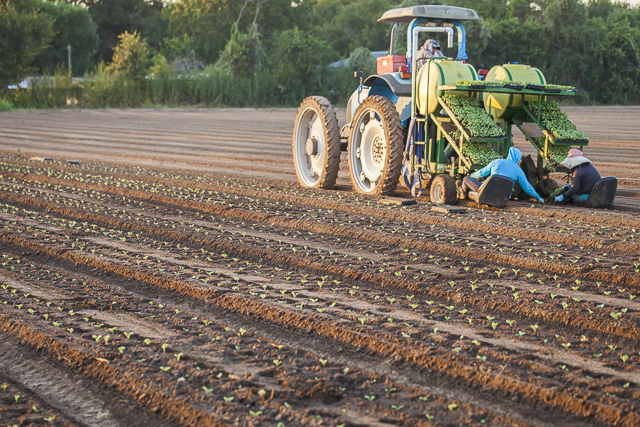 Newly planted fields. Photo by Scott David Gordon
Newly planted fields. Photo by Scott David Gordon
 More flowers! Photo by Scott David Gordon
More flowers! Photo by Scott David Gordon
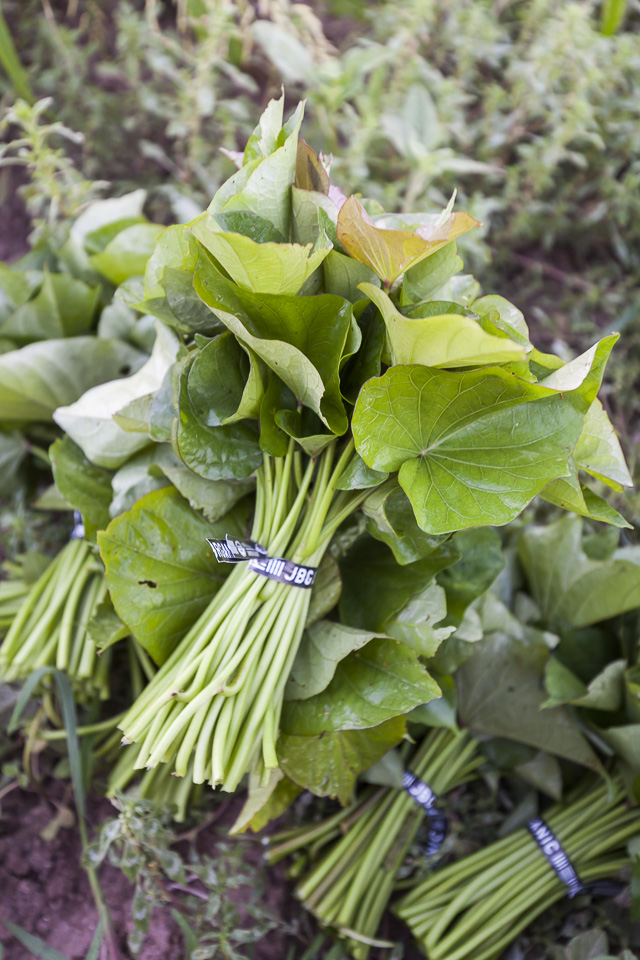 Sweet potato greens are looking great this week! Photo by Scott David Gordon
Sweet potato greens are looking great this week! Photo by Scott David Gordon
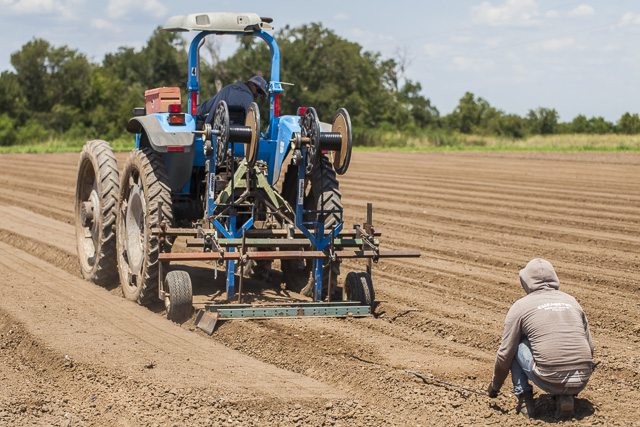 Laying drip tape on newly seeded beds. Photo by Scott David Gordon
Laying drip tape on newly seeded beds. Photo by Scott David Gordon
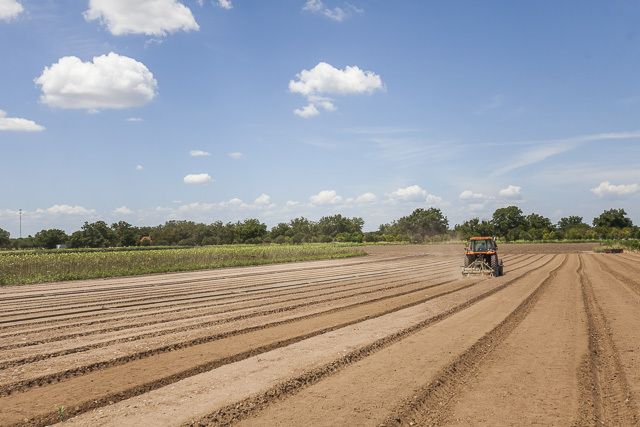 We're shaping beds for more Fall transplants! Photo by Scott David Gordon
We're shaping beds for more Fall transplants! Photo by Scott David Gordon
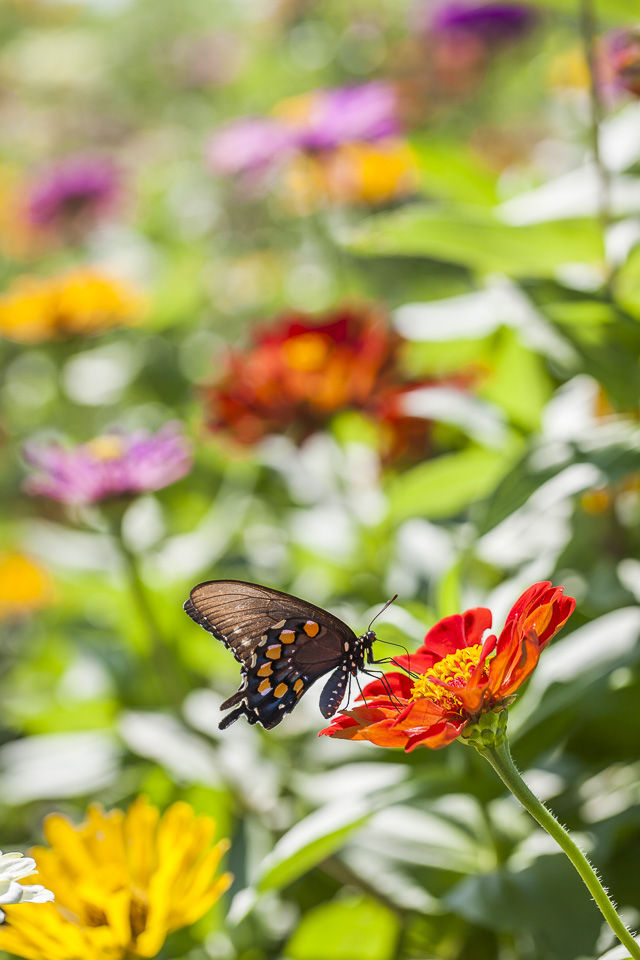 Photo by Scott David Gordon
Photo by Scott David GordonFIRST FRIDAY STAFF PICKS
09/04/15 — Farm
- This version of While My Guitar Gently Weeps -- currently playing at the JBG Garfield offices
- Our barn crew having a moment with baby animals: here, here, here, and here.
- To eat: Mike Mo from our wholesale department has been eyeing steak with a side of JBG veggies from our friends over at Dai Due
- Current schemes: steal Brenton's VW bus, road trip to the FarmAid 30 Concert on September 19 (who's coming with?!)
- City folk just don't get it.
- The ABGB is hosting the biggest Barton Springs Pool Jump ever. And then a birthday party at the brewery! Happy birthday, guys!
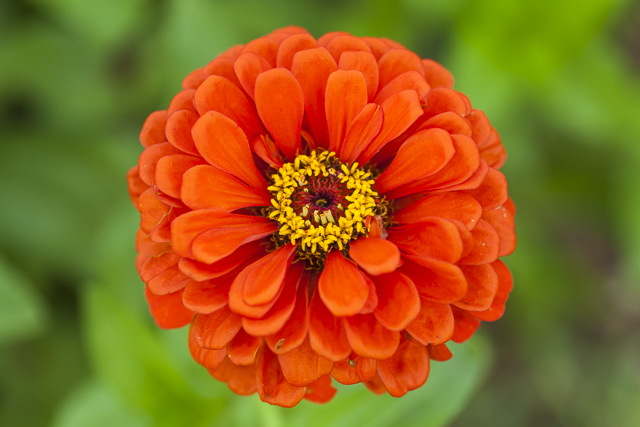 Photo by Scott David Gordon
Photo by Scott David GordonFTFP: ORGANIC CERTIFICATION
09/04/15 — Farm
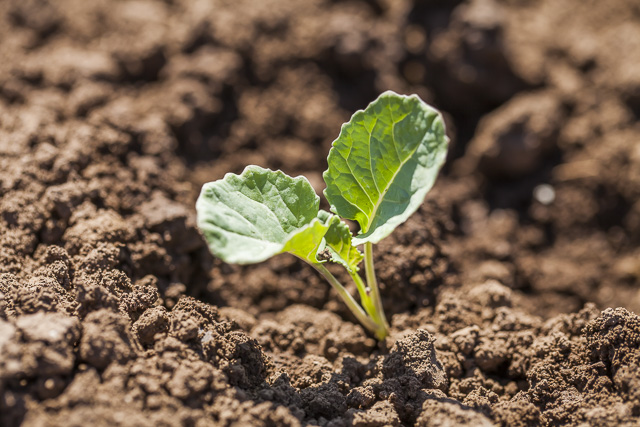 A young broccoli plant gets its start. Photo by Scott David Gordon
A young broccoli plant gets its start. Photo by Scott David Gordon
From the Farmer's Perspective: Organic Certification
Heads up: this week's blog post is a long one!
As we spend the weeks hurdling towards Fall on the farm, busily trying to finalize crop plans, purchase seeds, and get the fields prepared (how many hours in a day again?), we are also gathering our paperwork for a very significant day at the farm: our annual organic inspection and re-certification. This year, I thought it would be a good opportunity to tell the JBG community a little bit more about our growing practices at the farm, because "organic" can manifest itself in a number of different ways and I'm very proud of what we've accomplished here. It also dawned on me that you might not be aware of what an organic certification looks like, and we wanted to let you in on the process.When I first started in the backyard garden, I knew each and every one of my customers, and I didn't need a USDA seal to tell them about my growing practices. When I became a full time farmer in 2008, we made the decision to undergo our first organic certification, and man, am I glad I made that decision early on! The biggest lesson I've learned is that organic certification requires some meticulous record keeping - tracking all of your crops from seed to sale. Now that we're on 200 acres, that record keeping has gotten extremely complex, so I am grateful that our organic certification required us to develop our record-keeping systems early on.
We are certified organic Nature's International Certification Services (NICS), based out of Wisconson. Nature's International Certification Services. When our certifier comes for their annual farm inspection this Fall, we'll take them on a grand tour of JBG. This includes a field walk, facilities inspections, a look into where we store seeds, tools, amendments, soils, etc., and a sit-down interview where we review our 5 year Organic System Plan (OSP), our records from the previous year and plans for the coming one. We'll walk through an audit of a crop or multiple crops, tracking the vegetable from purchase of organic seeds, through our greenhouse and planting in the field, to weeding and pest management, to harvest and finally to the customer. Wow! We'll go into the details of everything from our buffer zones around the farm, to logo colors and placement on our CSA boxes. It's an extremely long and detailed process, but thanks to a hard working staff I know that we have all of our ducks in a row. For the large part though, the certification is looking for the following areas of our production system, with a few details on how we do it at JBG:
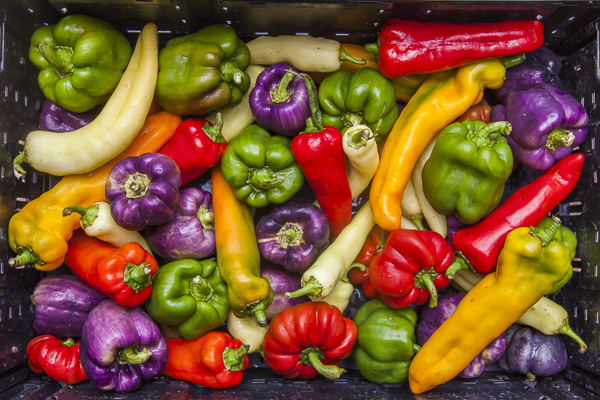 Pepper abundance. Photo by Scott David Gordon
Pepper abundance. Photo by Scott David Gordon
1. Long-Term Soil Fertility through Ecological Methods
When we grow nutrient-rich food for you and your families, we're pulling a lot of organic matter and nutrients out of our soil! As organic producers, we don't use synthetic fertilizers on the farm, which can cause unintended ecological harm, but rather use natural materials and grow our own fertility:
- Crop Rotation: different types of vegetables take different nutrients from the soil. Our Kale will tackle your vitamins A and K requirements, while Tomatoes have you covered on vitamin C and biotin! We never plant the same crop twice in a row on the same piece of land, but we rotate our crops around the farm to ensure that we don't deplete our soil of any one nutrient.
- Cover Crops: Did you know that you can actually grow your own fertility? As part of our crop rotation system, we include blocks of cover crops, also known as "green manures," to build both soil fertility and microbiology. This mix of grasses and leguminous crops is planted specifically to be turned back into the soil when fully grown, enriching it with organic matter and nitrogen fixing bacteria from the legumes!
- Compost compost compost! We make sure to add a lot of compost back into our soil - we want to make sure our vegetables have everything they need to grow you the healthiest food! In addition to compost, we are also able to add harder-to-find nutrients into our soil by using things like crushed rocks, bones, or feathers (byproducts of the agriculture industry), and marine products that are byproducts of the fishing industry.
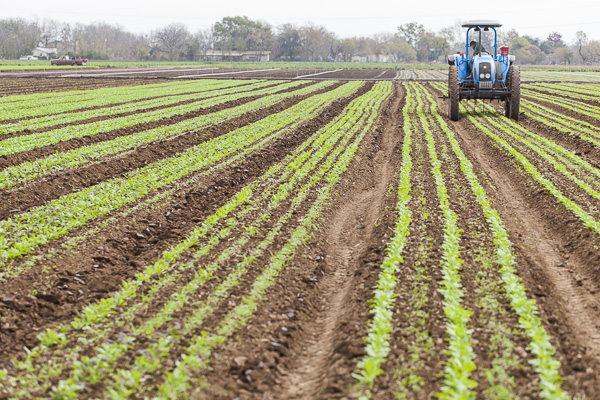 Tractor work at the farm. Photo by Scott David Gordon
Tractor work at the farm. Photo by Scott David Gordon
2. Natural Pest Management
The general idea behind pest management at JBG, is that if you have healthy soil and are growing seasonally appropriate crops and varieties, your plants should be heathy and free of pests and disease! This isn't always the case though, and we use an integrated pest management (IPM) system to address our plant health on the farm.
- Attract predators: Have you seen our farm flowers yet? In addition to being a beautiful farmer's market buy, our farmscaping efforts have been attracting all kinds of great insects to the farm! In addition to pollinators like honey bees, flowering plants attract ladybugs to combat aphids, syrphid flies to attack thrips, and lacewings for pesky caterpillars! We like to let some of our fennel, parsley and arugula crops go to seed to help feed the good bugs as well. Finally, we installed bat houses on the farm earlier this year, a unique Austin solution to combating crop-eating bugs!
- Natural compounds: sometimes, in order to save a crop, we have to attack the pests ourselves. If you remember earlier this year, Temo injected a mix of rosemary oil and other natural herbal oils to our drip system to save our potatoes after a cool, damp Spring season! We use this method of organic-approved compounds as a last resort, since we don't want to hurt those beneficial insects as well.
- Physical methods: Our Head Grower, Temo, also came up with the great idea to vacuum bugs off of the crops this year! Have I mentioned how great Temo is at his job? Another physical method we use is our crop rotation - by growing a crop in a different area of the farm each year, we try to keep pests from finding it - like a grower's game of hide and seek. Our big plans for the future are to grow alternating years between two different farm locations, both to help break the pest cycle and increase soil fertility. This is also how we manage weeds on the farm -- lots and lots of physical labor. While we do use tractors to help us weed, a large majority is done by hand, by our hard working field crews!
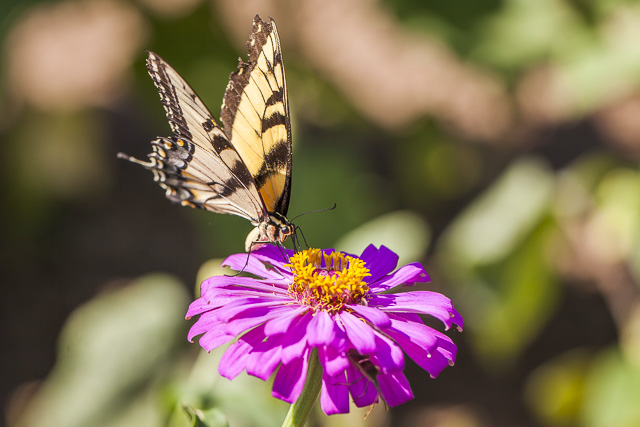 Scott captures a pollinator on one of our zinnias. Photo by Scott David Gordon
Scott captures a pollinator on one of our zinnias. Photo by Scott David Gordon
3. Biodiversity on the Farm and Surrounding Ecosystem
As a general rule, ecosystems that have more biodiversity - number of different plants, animals, insects, etc - are inherently more stable and healthy without additional inputs. We strive to achieve this at JBG in a number of ways:
- Diverse mix of crops: did you know that we grew over 250 different varieties of crops last year? While this leads to a lot of record-keeping, it also provides you and your family with a plethora of options in your CSA boxes!
- Farmscaping: Our flowering plants attract a huge variety of beneficial insects and pollinators to the farm, which also helps with pest management!
- Buffer zones and riparian areas: We maintain a 40 ft zone around the entire farm to avoid material drift, and to provide habitat for native plants and animals. In addition, we have a buffer around the waterways that run around and through our farm, which are host to a number of birds, bees, animals, reptiles, and more!
I've probably put some of you to sleep by now, too, but that's okay too. Either way, I hope to see you at one of our farmers markets this weekend!
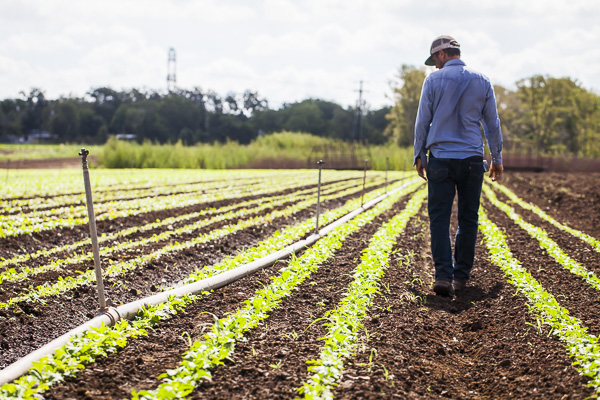 Brenton on a field walk. Photo by Scott David Gordon
Brenton on a field walk. Photo by Scott David GordonFRITTATA WITH SWEET POTATOES & GREENS
09/08/15 — Farm
By Megan Winfrey
As I unpacked last weeks CSA box, I immediately recognized the large bouquet of leafy greens at the very top. I'd seen them used many times in my former life as a restaurant manager. Yes, I am talking about you, sweet potato greens. I remember the chef comparing them to spinach - one of my absolute favorite greens - so I couldn't wait to experiment. I thought a simple but delicious frittata would be the perfect introduction.
Frittata with Sweet Potatoes & Greens
- 8 eggs
- 1/2 cup of onion, diced
- 3 cloves garlic, diced
- 3-4 small sweet potatoes, cooked and chopped
- 1 bouquet sweet potato greens, chopped
- 3 slices of bacon, chopped (optional)
- 1/2 cup fresh mozzarella cheese, diced
- 1/2 cup cheddar cheese, shredded
- 1/4 cup cilantro, chopped
- 1/2 cup whole milk
- 2 tbs. olive oil or butter
- salt & pepper
Oil or butter a large cast iron pan and heat over medium. Add the onions and bacon and cook for about 5 minutes. Add the garlic, sweet potatoes, and sweet potato greens and cook until the greens are just wilted, about 2-3 minutes.
Crack the eggs into a bowl, add the milk, and beat until just combined. Do not over beat the eggs! This will make your frittata dense instead of fluffy.
Pour the egg mixture into the pan, over the cooked vegetables and bacon. Stir in the cheddar cheese, salt & pepper, and strategically drop the mozzarella chunks throughout. Cook over medium heat until the edges begin to brown and the center starts to firm up. Sprinkle the chopped cilantro over the top before placing it in the oven.
Finish it off in a 350ºF oven for about 15 minutes, until the center doesn't giggle when shaken.
Let cool for a couple of minutes, slice it like a pie, and marvel at those ooey gooey mozzarella chunks. Enjoy!
CSA BOX CONTENTS WEEK OF SEPT 7TH
09/08/15 — Scott
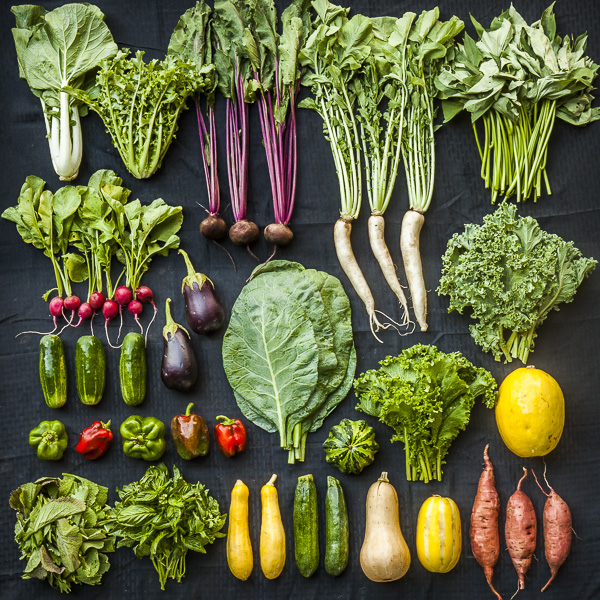 CSA Box Contents Week of Sept 7th
CSA Box Contents Week of Sept 7th
Beet, Red
Bok Choy
Cucumber, Pickling
Eggplant , Black
Greens, Collards
Greens, Kale, Curly
Herb, Basil
Lettuce, Endive
Okra
Pepper Bell, Green
Potato, Sweet
Squash, Butternut
Squash, Zucchini
Bok Choy
Eggplant , Black
Greens, Braising Mix
Greens, Collards
Greens, Kale, Curly
Herb, Basil
Pepper Bell, Green
Potato, Sweet
Squash, Spaghetti
Squash, Zucchini
Beet, Red
Cucumber, Pickling
Greens, Kale, Curly
Greens, Sweet Potato
Okra
Pepper Bell, Green
Squash, Patty Pan
Bok Choy
Greens, Collards
Pepper Bell, Green
Potato, Sweet
Squash, Zucchini
CSA BOX CONTENTS WEEK OF SEPT 7TH
09/08/15 — Scott
WEEK 37 IN PHOTOS
09/11/15 — Farm
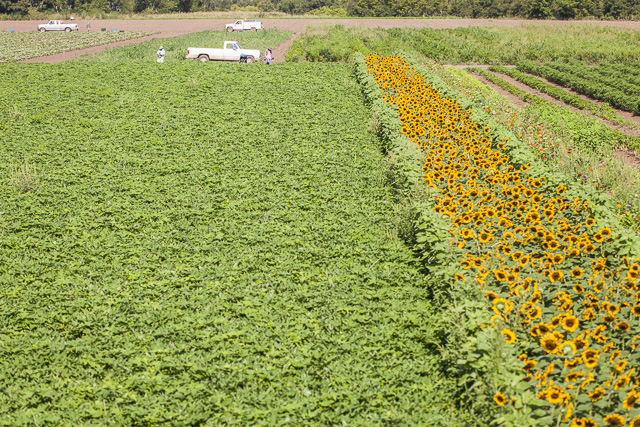 Scott captures an ariel view of our sunflowers and sweet potatoes. Photo by Scott David Gordon
Scott captures an ariel view of our sunflowers and sweet potatoes. Photo by Scott David Gordon
I can't believe how great the farm looks these days! After all of the flooding this Spring, I was worried, but right now you would never know anything strange had happened. The fields are almost entirely planted for Fall and everything is growing like crazy. This week we're excited about the first harvest of green beans from our most recent planting. The cabbage and broccoli we've been transplanting is shaping up really nicely, and we have an abundance of fall greens, from Collards and Kale, to Mustards, Mizuna, and more. Thanks to Scott David Gordon for capturing this week in images!
 We harvested our first Green Beans from this planting this week. Photo by Scott David Gordon
We harvested our first Green Beans from this planting this week. Photo by Scott David Gordon
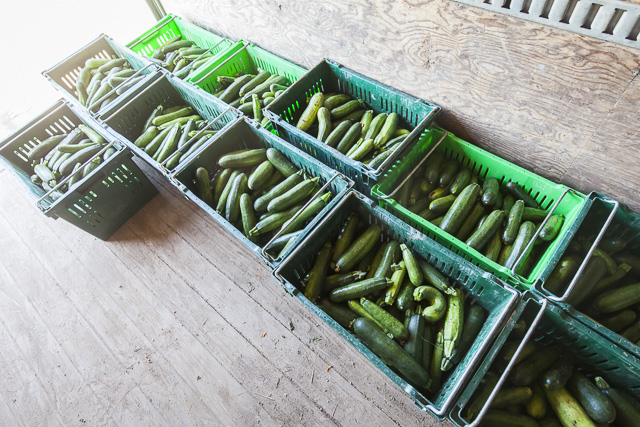 Zucchini harvest resting in the shade. Photo by Scott David Gordon
Zucchini harvest resting in the shade. Photo by Scott David Gordon
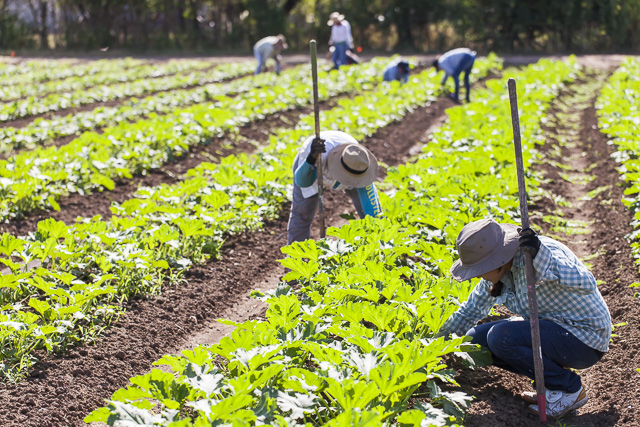 It's been nearly a year without plastic on the farm! Hand-weeding squash. Photo by Scott David Gordon
It's been nearly a year without plastic on the farm! Hand-weeding squash. Photo by Scott David Gordon
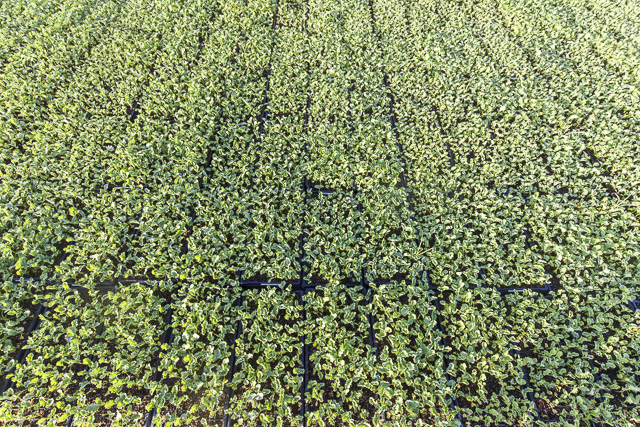 Kale transplants in the greenhouse Photo by Scott David Gordon
Kale transplants in the greenhouse Photo by Scott David Gordon
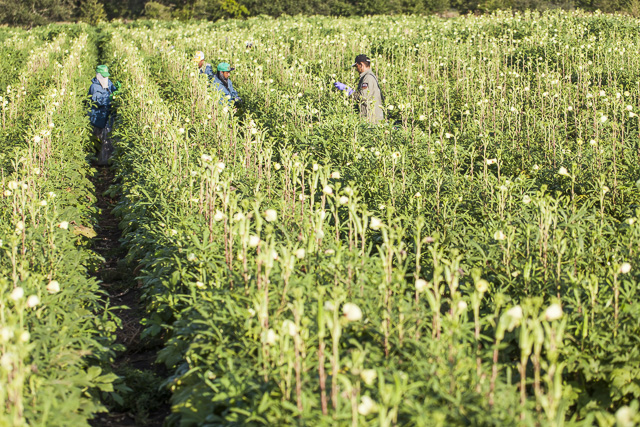 Tall okra plants during an early morning harvest. Photo by Scott David Gordon
Tall okra plants during an early morning harvest. Photo by Scott David Gordon
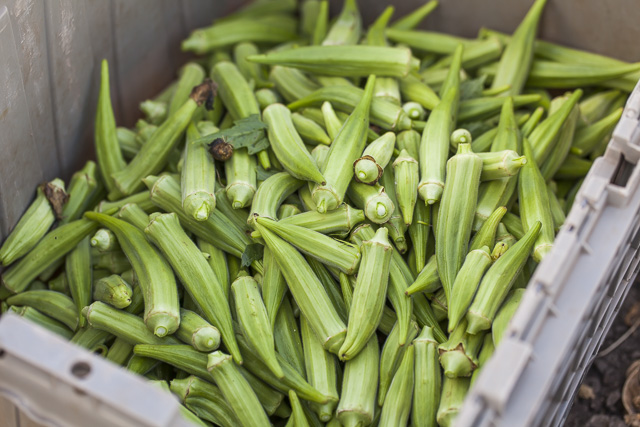 Okra. Photo by Scott David Gordon
Okra. Photo by Scott David Gordon
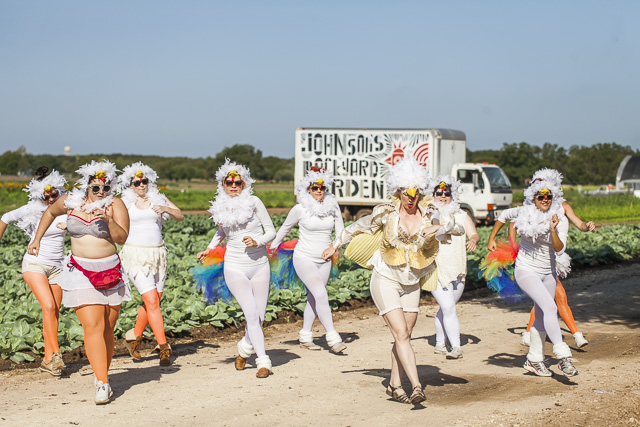 What was this flock doing on the farm? Filming for the next episode of Workout! By Erica Nix. Don't miss the video when it launches! Photo by Scott David Gordon
What was this flock doing on the farm? Filming for the next episode of Workout! By Erica Nix. Don't miss the video when it launches! Photo by Scott David Gordon
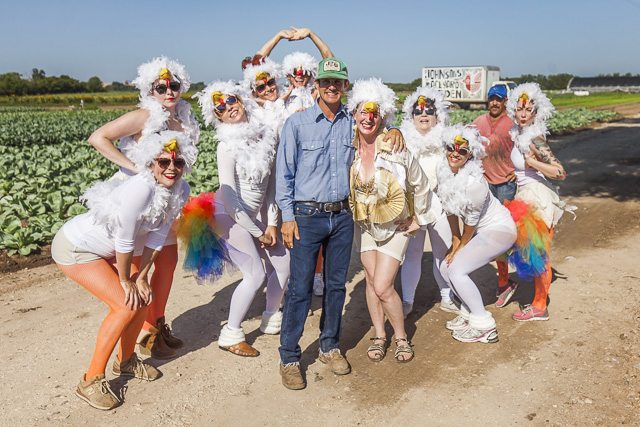 Thanks for coming out to the farm, Erica and crew! Photo by Scott David Gordon
Thanks for coming out to the farm, Erica and crew! Photo by Scott David Gordon
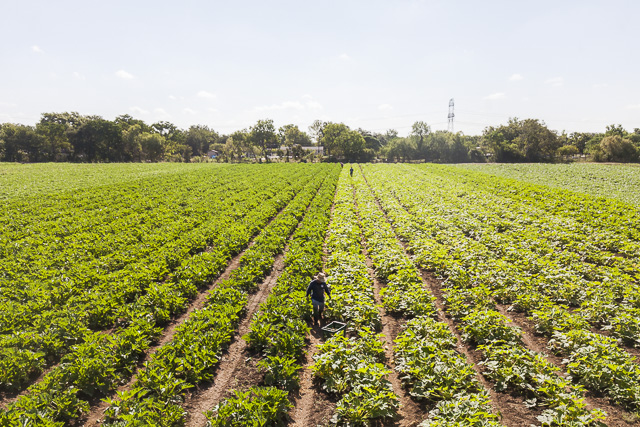 The fields are looking beautiful right now. Photo by Scott David Gordon
The fields are looking beautiful right now. Photo by Scott David Gordon
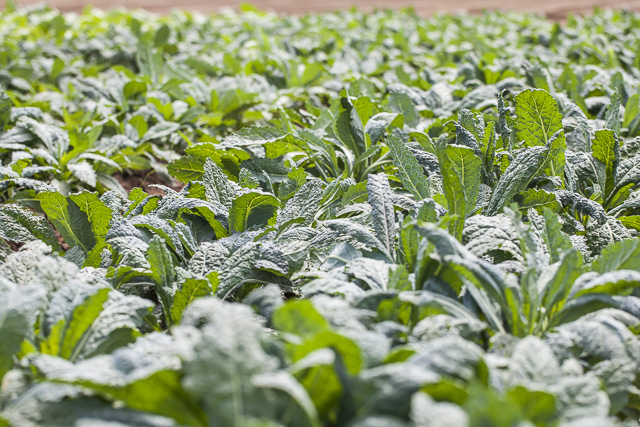 Lacinato kale. Photo by Scott David Gordon
Lacinato kale. Photo by Scott David Gordon
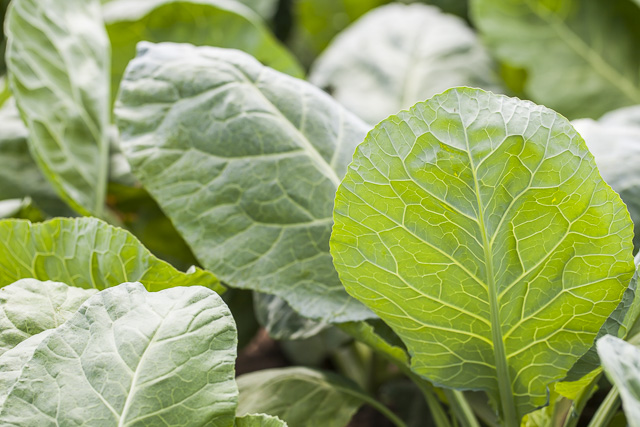 Young collards in the field. Photo by Scott David Gordon
Young collards in the field. Photo by Scott David Gordon
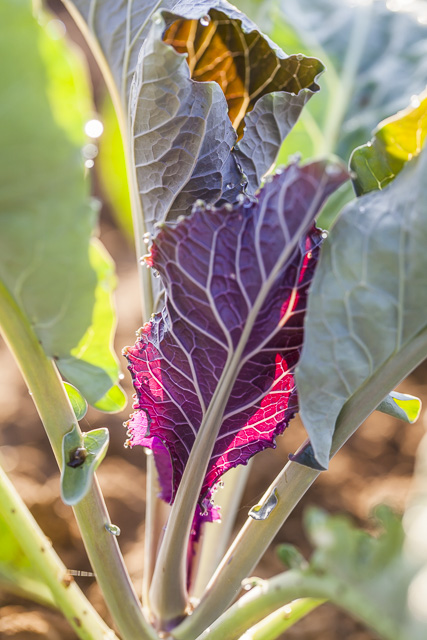 Red cabbage is growing nicely. Photo by Scott David Gordon
Red cabbage is growing nicely. Photo by Scott David Gordon
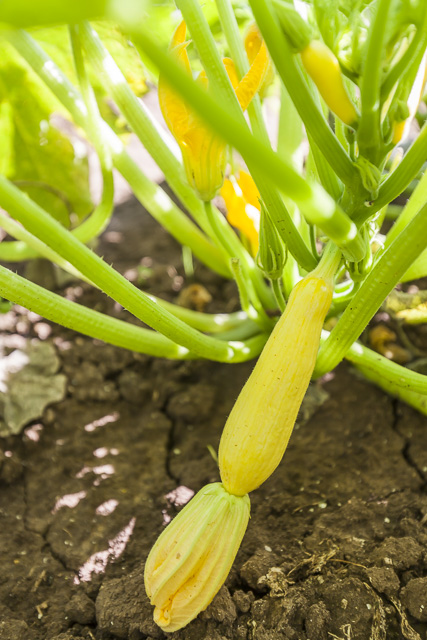 Yellow squash. Photo by Scott David Gordon
Yellow squash. Photo by Scott David Gordon
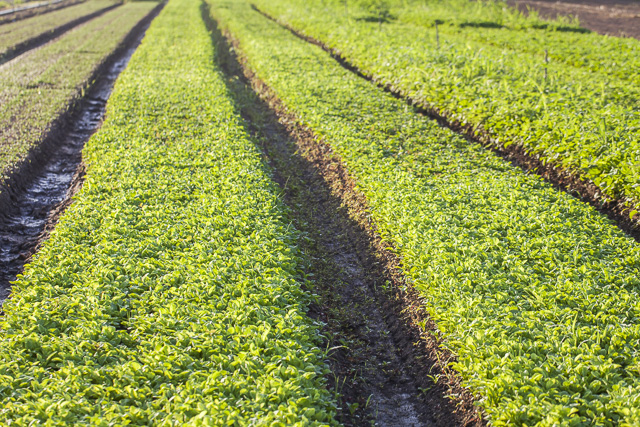 Baby greens. Photo by Scott David Gordon
Baby greens. Photo by Scott David Gordon
 Cabbage is growing quickly! Photo by Scott David Gordon
Cabbage is growing quickly! Photo by Scott David Gordon
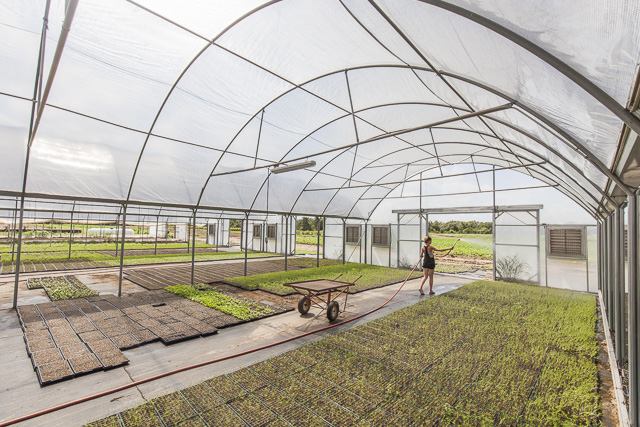 Adrienne watering in the greenhouse. Photo by Scott David Gordon
Adrienne watering in the greenhouse. Photo by Scott David GordonLA FINCA - JBG VISITS CUBA
09/11/15 — Farm
When the United States, amidst communist fears, instituted its trade embargo against Cuba in 1960, the country relied on the Soviet Union as its trading partner. When the Iron Curtain fell, however, and the Soviet Union dissolved, Cuba lost access to much of the machinery and pesticides it had depended upon. Despite this, the country met the economic and agricultural turmoil head on and in the end emerged as one of the world’s leaders in efficient and organic farming.
While photographing and studying DIY (Do It Yourself) culture in Cuba, I visited farms across the western half of the island meeting farmers and learning about their (amazing) solutions to these resource shortages. Having James along for the ride allowed for some fantastic cultural exchange and great conversation about – you guessed it – vegetables. We left a little piece of JBG with each of these farmers and returned with a wealth of knowledge and some great memories. Here are a few of our favorites:
This is Tony, who helps run his family-owned farm, Finca Acroecologica El Paraíso. Using biofertilizers, produced by insects and animals like geese and rabbits, the finca generates enough vegetables and fruits to feed Tony and his wife, Rachel, their large family, and the flow of visitors that comes to the on-site restaurant for lunch and dinner daily.
When I first visited the finca, I gave this JBG bag to Rachel, who operates the restaurant. James was wearing his JBG shirt when we returned, and she immediately recognized it. Before serving us one of our best meals in Cuba, Rachel ran to the back to show us that she is still proudly toting the bag around Viñales.
This is Esteban, a young campesino in the Valle de Viñales, who lives on his family farm and works both tending to the land and taking care of the horses. The Valle de Viñales is “off-the-grid” and instead operates on solar energy. Many farmers like Esteban have houses outfitted with solar panels.
Esteban lights a cigar, homemade with local tobacco. Viñales is located in the Pinar del Río province, which is known for its tobacco, growing 70 percent of Cuba’s much-coveted crop. Almost all of the tobacco grown in Cuba is organic.
It’s important to stay hydrated in Cuba’s almost unbearable heat (especially in August!) so Esteban scaled a tree and before we knew it, we were all sipping fresh coconut water. Baracoa, a town in eastern Cuba, is considered the coconut capital, but we were plenty happy with these fruits from the west.
Meet El Negro, a self-sustaining farmer who lives deep in the Valle de Viñales harvesting fruits, vegetables, and coffee among other things. El Negro stands in front of his newly built house, which he constructed with his own two hands and the help of some neighbors.
One of El Negro’s largest crops is yuca (or cassava). Photographed here, El Negro has just harvested young yuca. Generally, this root is not harvested until a year or so after planting. El Negro and Esteban return to El Negro’s house from a visit to the fields to check on the crops. With fertile soil and the right climate, the Valle de Viñales is a rich agricultural area, growing everything from tobacco to bananas and beans.
After buying some mangoes from this kind man in the Valle de los Ingenios outside of Trinidad, he invited me to share some fruit with his friends, all of whom grow their own food. They loved looking at the array of vegetables that JBG grows and comparing their harvests.
For fun, I have also added a picture of this young boy in the streets of Habana Vieja. We gave him and his friends JBG stickers. They asked about the meaning of “JBG” and then ran around holding their stickers up in victory.
Thanks so much for sharing your adventure, Molly and James! Molly Mandell is currently a student at the University of Texas performing independent research for her thesis in the department of American Studies. You can see more at www.mollymandell.com. Hope you enjoyed her photos as much as we did!FTFP: A JBG PLAYGROUND, AND FARM TO SCHOOL
09/11/15 — Farm
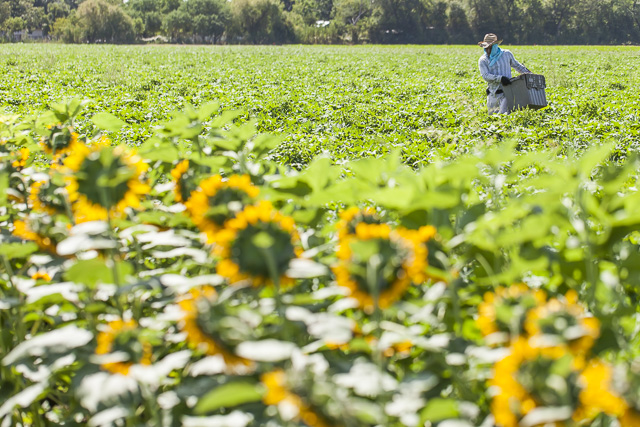 Photo by Scott David Gordon
Photo by Scott David Gordon
From the Farmer's Perspective: A JBG Playground and Farm to School
As many of you know, I really love art, and I’m always trying to find new ways to create space for artists on the farm (by the way - this Saturday is your last chance to check out Farmer as Artist at the Prizer Gallery!). I’ve also had a dream for a long time to create more community space at our farm, to make events like our spring and fall hoedowns an even more exciting place to bring the family. This week I wanted to let you in on a big project I’ve been working on - plans for a playground at the Garfield Farm!
With all of the seeding and planting and building going on at the farm, you might be wondering where I’m finding the time to think about things like a playground. I promise I’m not trying to do too much, but these sorts of things just seem to track me down! I have a funny knack for accidentally networking, and it seems like several times a week I connect with people by accident, and am inspired to take on new projects without seeking them out. Really! Remember how I went to see the Grateful Dead play in California? Well, on my road trip back to Austin, I met someone who put me in contact with a man named Mark Hemphill, who lives in Atlanta. While Mark and I haven’t actually met yet, we’ve certainly been in contact, and he’s a really creative guy! Right now he and I are collaborating on a design for a farm playground made from reused tractor tires, and I’m excited to share the beginnings of the project with you.
 I've been working with Mark Hemphill to visualize the re-use of some of our old tractor tires!
I've been working with Mark Hemphill to visualize the re-use of some of our old tractor tires!
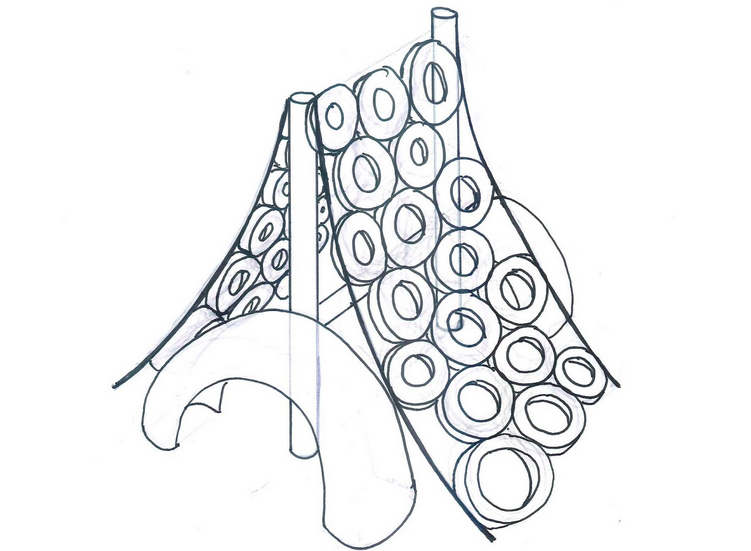
While this was just starting to take form, I made another really interesting connection at the farmers market a few weeks ago. I ran into a man named Paul Clarence Oglesby and his wife, and found out about Paul's sculptural art. Paul works in concrete, and creates some really amazing forms and spires - I was amazed when I saw them! Paul also has a strong horticultural background, and a really neat permaculture garden at his house in Austin. It seemed like too perfect a coincidence! So, I’m working with Paul to plan for a project at the Garfield Farm - I was thinking we could integrate this work in with the kid’s playground! Between the recycled tires, Paul’s work, and of course some old vintage playground equipment, this playground is going to be a blast.
 An example of Paul Clarence Oglesby's work.
An example of Paul Clarence Oglesby's work.
While I don’t think we’ll have the playground ready for the Fall Harvest Hustle (October 24th is coming up soon! Have you saved the date yet?), maybe we’ll have it ready for the kids by Spring. If you have any ideas for our newest project, be sure to drop us a line.
We have another piece of great news for your kiddos this week, one that is sure to make school lunches a little more exciting. JBG has been approved to be an official vendor for the Austin Independent School District!! We are incredibly grateful and excited to be pairing up with Austin’s schools to provide fresh produce from a local farm. AISD parents can help us out by calling or writing to your school administration - let them know that you would love to see JBG on the menu! A huge thank-you to AISD for raising the standard on school nutrition programs and allowing us to feed the next generation of change-makers. You can find out more about how AISD is improving school lunch by visiting their website.
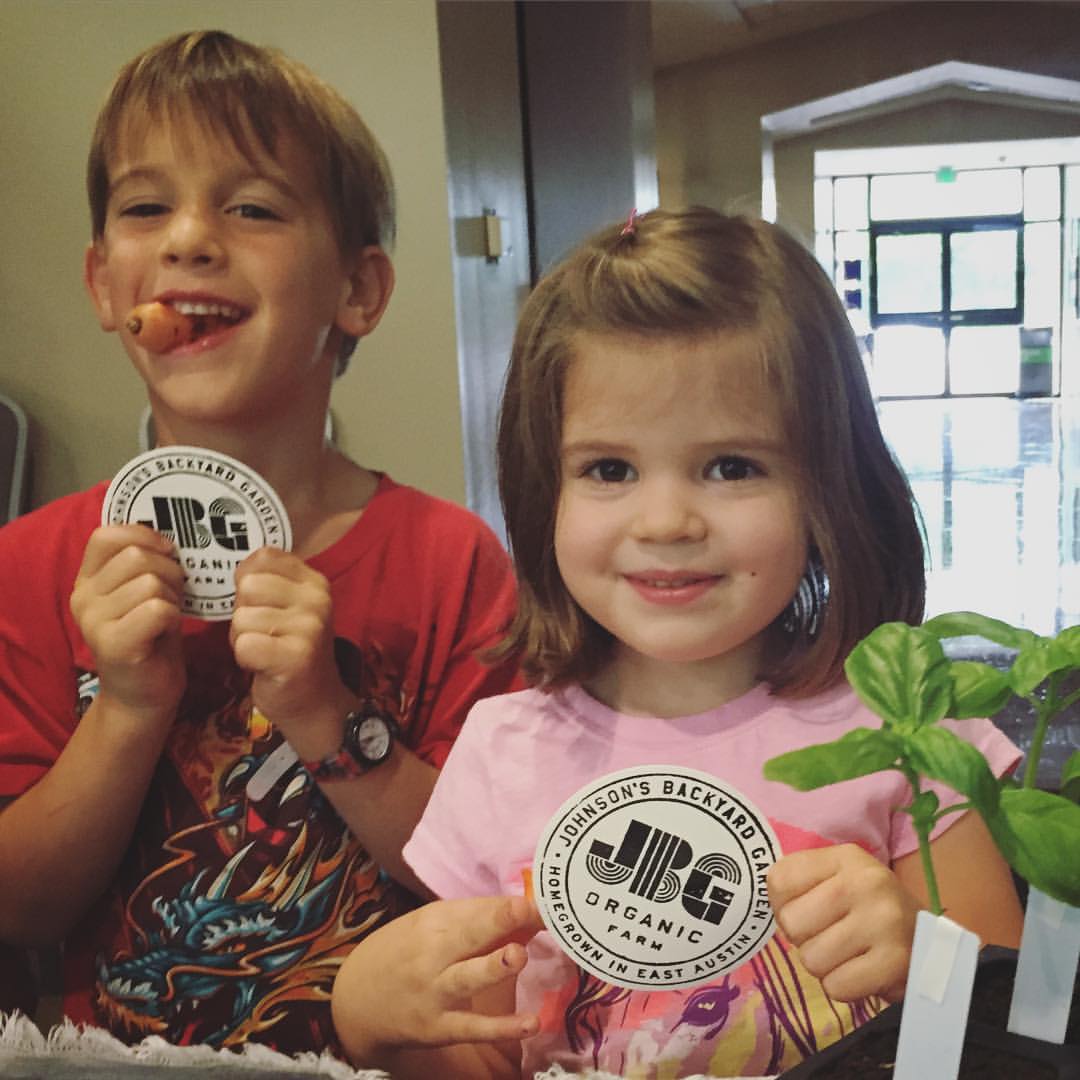 Growing healthy kids!
Growing healthy kids!
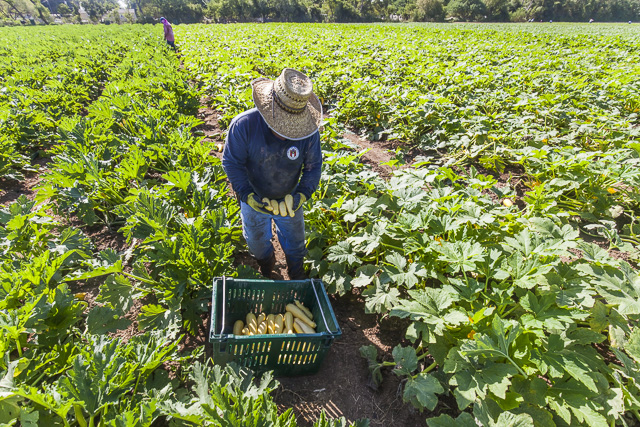 This yellow squash could be making it's way into your child's school lunch this fall! Photo by Scott David Gordon
This yellow squash could be making it's way into your child's school lunch this fall! Photo by Scott David Gordon
Now, with all of this said, I’ve got a ton of projects I’ve got to get moving on - we are hoping to finish a 12,000 square foot shade house by next week among all the other things! Be sure to say hi at one of our weekend markets - we’ve got a myriad of produce coming out of the fields right now. After a really challenging Spring and Summer, the farm is looking absolutely beautiful and I am so proud of the produce we are bringing to market - especially all of the new Fall greens coming in!
For more of the farmer’s perspective, follow Brenton on Facebook, Twitter, or Instagram @farmerbrenton.
CSA BOX CONTENTS WEEK OF SEPT 14TH
09/14/15 — Scott
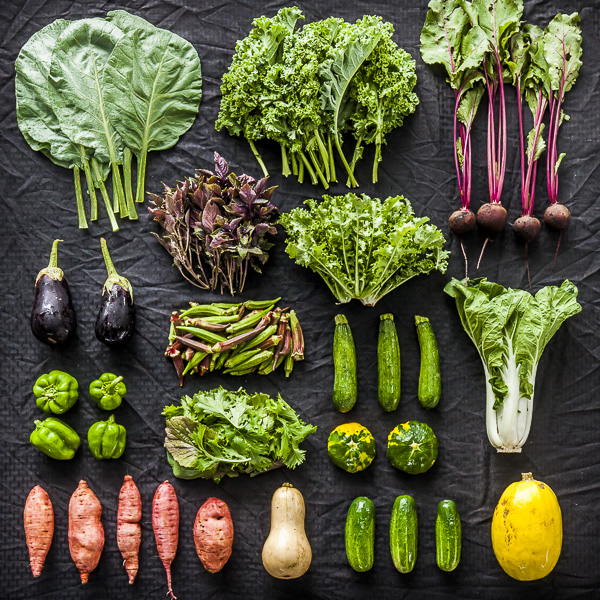 CSA Box Contents Week of Sept 14th
CSA Box Contents Week of Sept 14th
Beet, Red
Bok Choy
Cucumber, Pickling
Eggplant , Black
Greens, Collards
Greens, Kale, Curly
Herb, Basil
Lettuce, Endive
Okra
Pepper Bell, Green
Potato, Sweet
Squash, Butternut
Squash, Zucchini
Bok Choy
Eggplant , Black
Greens, Braising Mix
Greens, Collards
Greens, Kale, Curly
Herb, Basil
Pepper Bell, Green
Potato, Sweet
Squash, Spaghetti
Squash, Zucchini
Beet, Red
Cucumber, Pickling
Greens, Kale, Curly
Greens, Sweet Potato
Okra
Pepper Bell, Green
Squash, Patty Pan
Bok Choy
Greens, Collards
Pepper Bell, Green
Potato, Sweet
Squash, Zucchini
SMOTHERED OKRA OVER RICE
09/15/15 — Farm
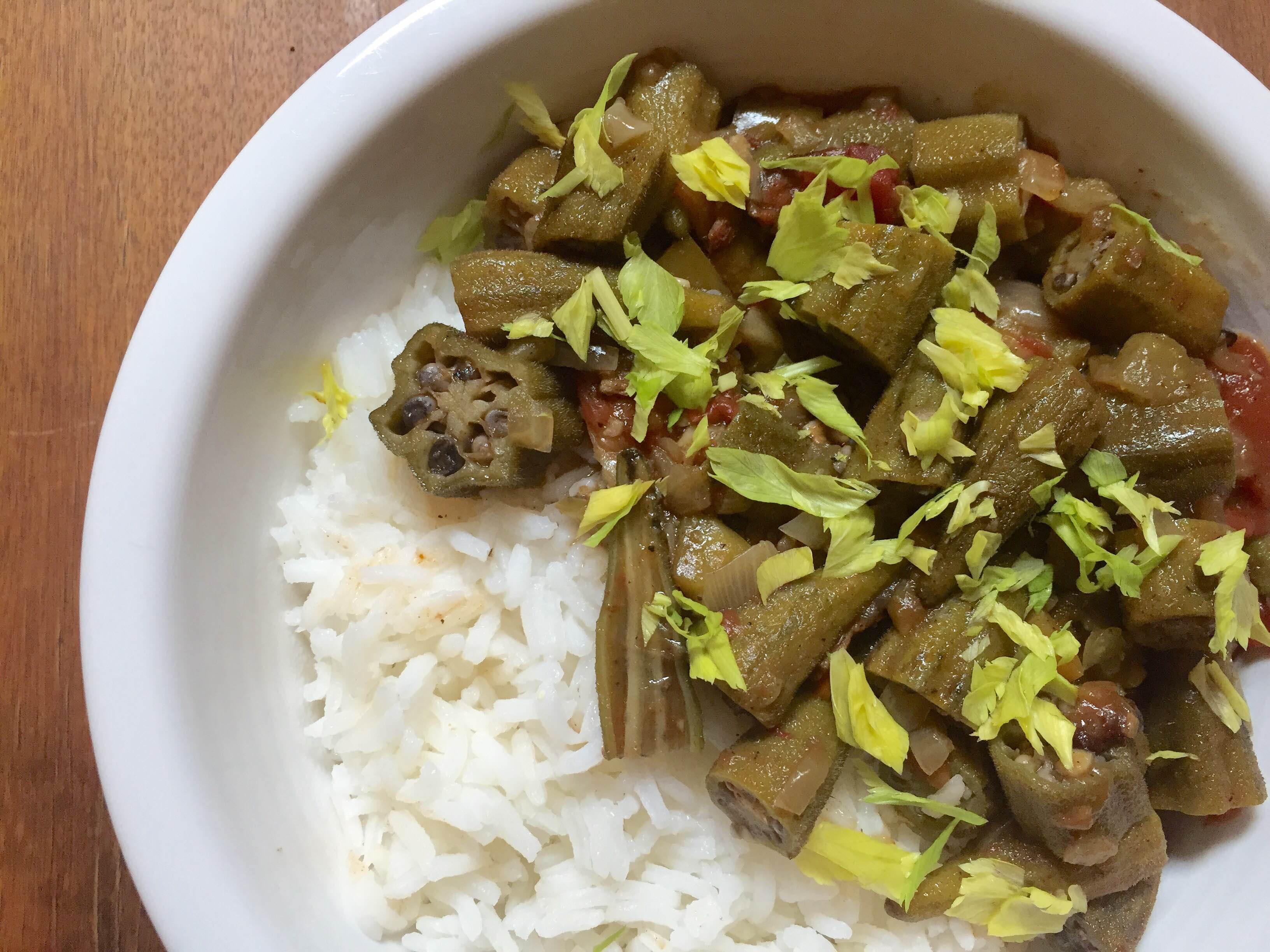
By Megan Winfrey
The weather is changing, and the most glorious of all seasons is upon us! I know, I know...we don't get to REALLY experience Fall here in Texas, but any reprieve from the heat, even if only for a few days, is much welcome and celebrated. 85 degrees? Give me a chai latte, leggings, and comfort food. After making this week's recipe, I've had all of those things today - and I'm feeling pretty good about it.
Smothered Okra over Rice
- 2 tbs. butter
- 3 slices of bacon, roughly chopped
- 4 garlic cloves, chopped
- 1 large sweet onion, roughly chopped
- 3 small JBG bell peppers, roughly chopped
- 1 stalk of celery, roughly chopped
- 2-3 lb. okra, trimmed and sliced to 1/2" thickness
- 1 cup chicken stock
- 1 tsp. dried thyme
- 2 tsp. sugar
- 1 tsp. cayenne pepper
- 1 can whole peeled tomatoes, crushed by hand (see photo)
- 1 bay leaf
- 1 cup white rice
- salt and pepper to taste
Heat the butter over medium in a dutch oven or deep skillet. Add the bacon and cook until the fat renders. Add the garlic, onion, bell peppers, and celery and cook until golden, about 10 minutes. Stir in the remaining ingredients and bring to a boil. Cover, reduce heat to medium-low and cook until okra is tender, about 45 minutes to an hour.
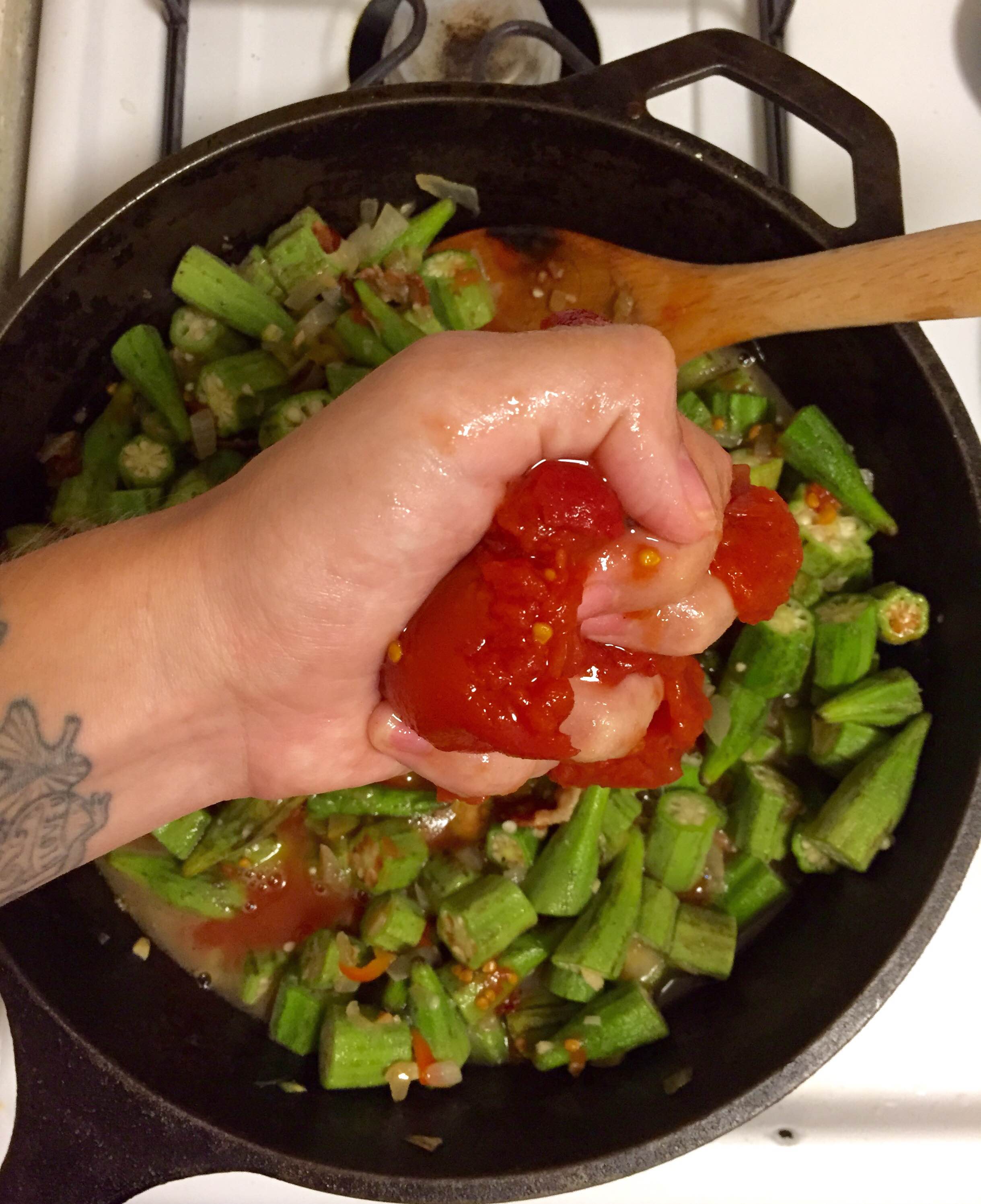
Prepare the rice according to the packaging. I always do 1 cup of rice, 2 cups of water, and a pat of butter. Bring to a boil, stir, cover, reduce to low, and let simmer for 15 minutes. Remove from the heat but keep the lid on for another 10 minutes until all the moisture is absorbed.
Serve the smothered okra over the rice, garnish with celery leaves if desired.
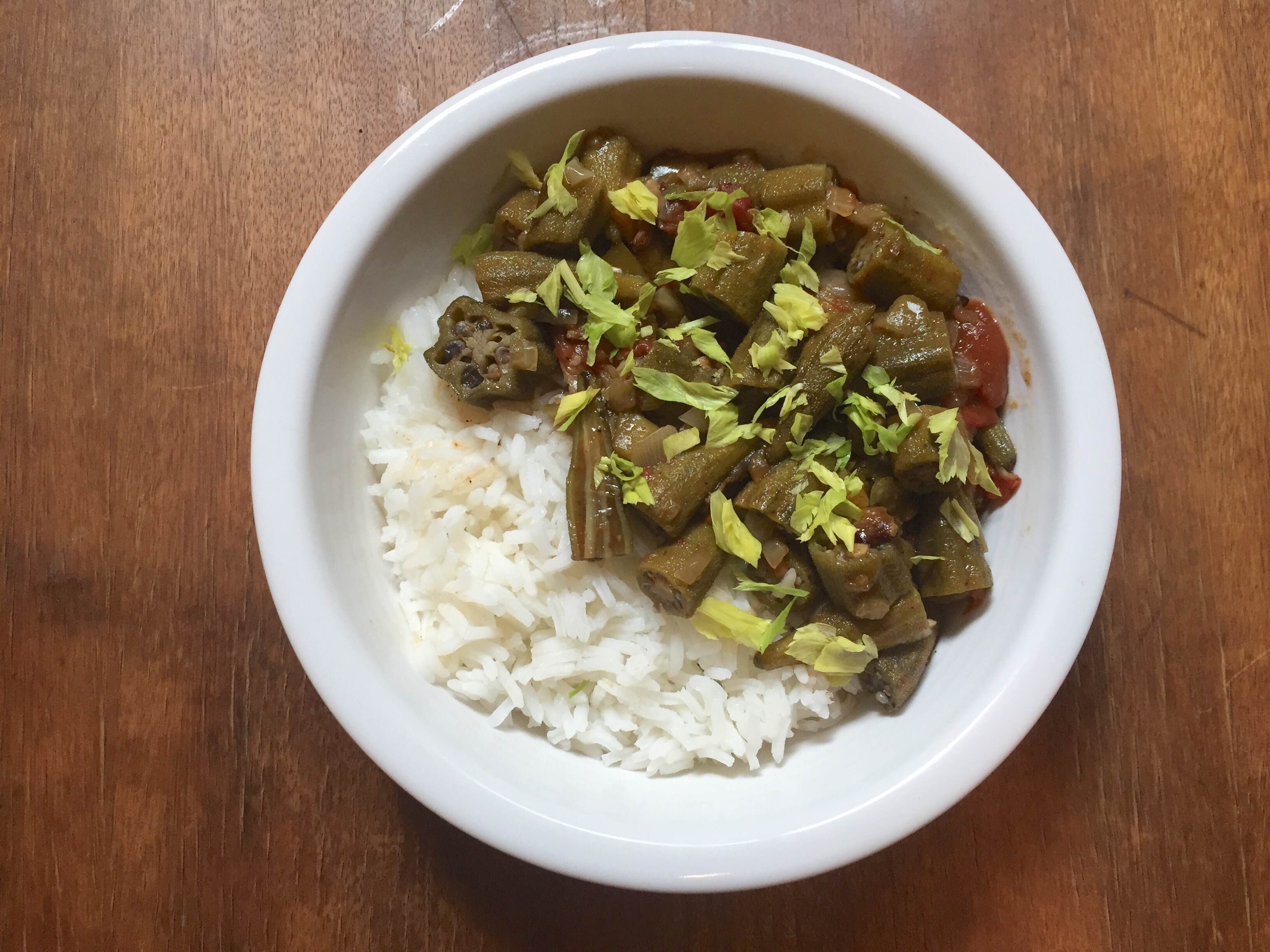
CSA BOX CONTENTS WEEK OF SEPT 14TH
09/15/15 — Scott
 CSA Box Contents Week of Sept 14th
CSA Box Contents Week of Sept 14th
Medium Box
Bok Choy
Eggplant , Black
Greens, Braising Mix
Greens, Collards
Greens, Kale, Curly
Herb, Basil
Pepper Bell, Green
Potato, Sweet
Squash, Spaghetti
Squash, Zucchini
JBG WEEKEND READING
09/18/15 — Farm
3 bits of reading from around the web for you to check out this weekend... enjoy!
Photo by Scott David Gordon
Ever feel overwhelmed on your CSA pickup day? Unsure of how to tackle that mountain of produce? Well, our friend Rachel Johnson breaks it down for you on Cooking Light this week, and we thought her explanation was so great we wanted to share it with you!
NCAT's Southwest Office in San Antonio just released its Feasability Study for a Texas Organic Food Hub. We are highly supportive of this effort of NCAT and the USDA to promote and accelerate the growth of organic farms in Texas.
Scott James is going to be setting up his typewriter and writing poetry at JBG's Fall Hoedown this year - check out his Instagram for a preview of his project! The Hoedown, set for October 24th, is only 5 weeks away and we couldn't be more excited!!
WEEK 38 IN PHOTOS
09/18/15 — Farm
 Miguel sure looks happy to be harvesting bok choy! Photo by Scott David Gordon
Miguel sure looks happy to be harvesting bok choy! Photo by Scott David Gordon
Thank you, Scott David Gordon, for capturing these beautiful images from the farm this week. As you can see, things are VERY green around JBG these days. We've got a slew of Fall crops, especially greens, coming out of the fields, and this week's favorite has got to be this beautiful bok choy. Our greenhouses are full to bursting, and we're keeping busy seeding more fall favorites each week. If you haven't been out to the Garfield Farm recently, you can still sign up for a volunteer spot in our greenhouses 7 days a week by emailing us at volunteer@jbgorganic.com. Hope to see you out there!
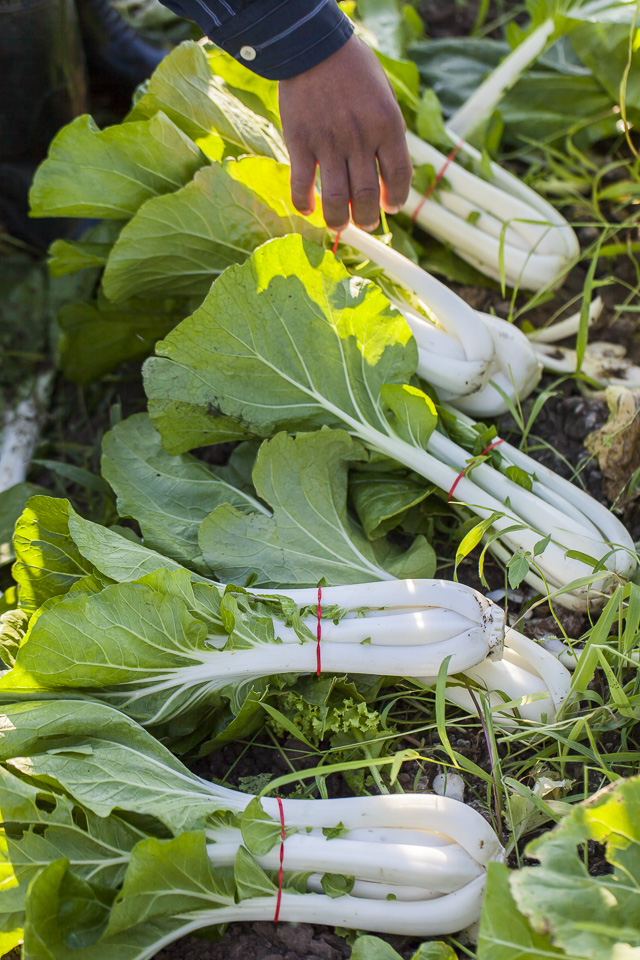 Bok choy in the field. Photo by Scott David Gordon
Bok choy in the field. Photo by Scott David Gordon
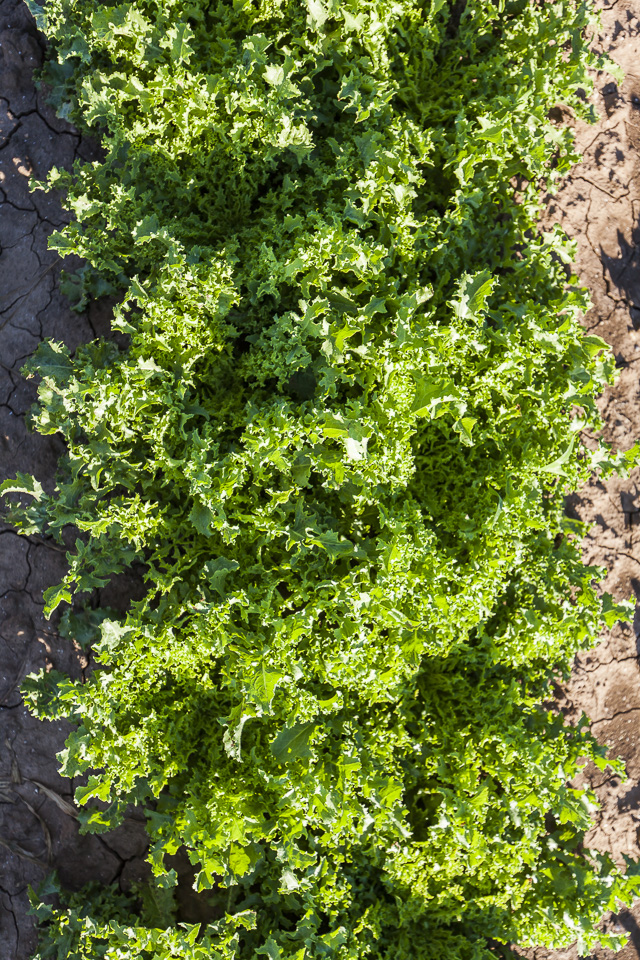 Curly endive. Photo by Scott David Gordon
Curly endive. Photo by Scott David Gordon
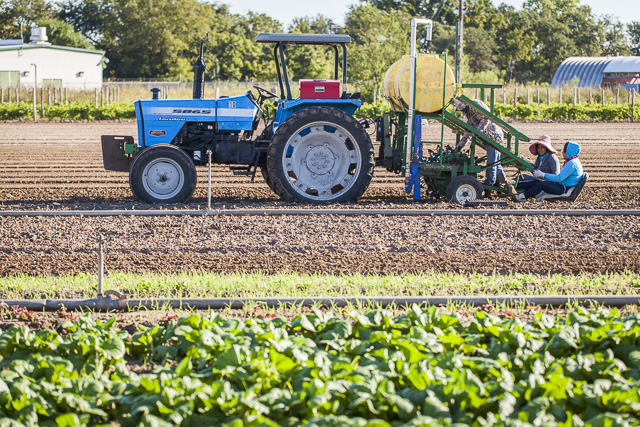 There is still a ton of transplanting to do. Photo by Scott David Gordon
There is still a ton of transplanting to do. Photo by Scott David Gordon
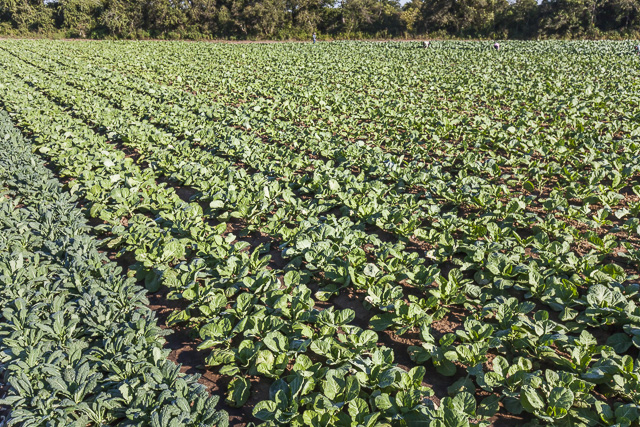 Fields of green. Photo by Scott David Gordon
Fields of green. Photo by Scott David Gordon
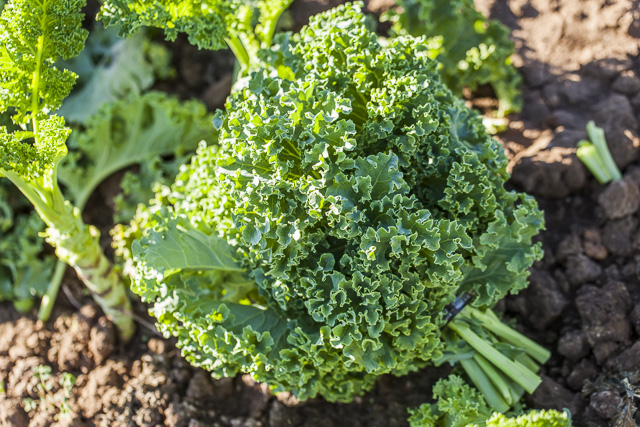 The curly kale is looking great out there! Photo by Scott David Gordon
The curly kale is looking great out there! Photo by Scott David Gordon
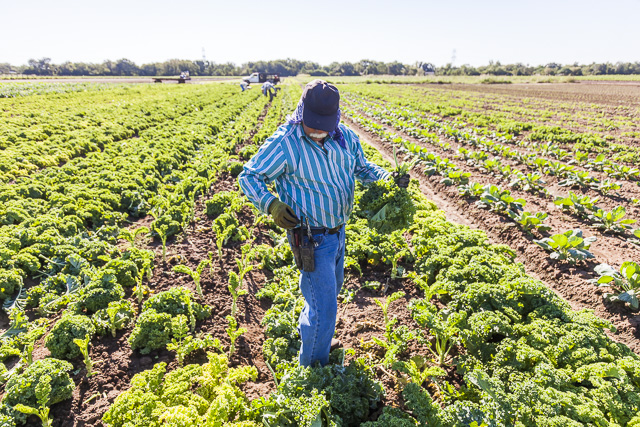 Curly kale harvest. Photo by Scott David Gordon
Curly kale harvest. Photo by Scott David Gordon
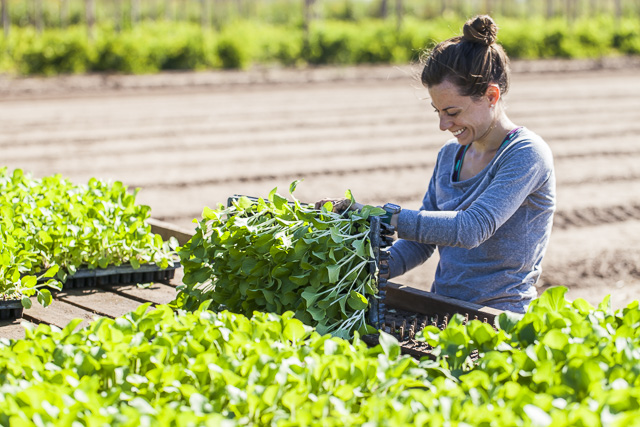 Getting ready to transplant. Photo by Scott David Gordon
Getting ready to transplant. Photo by Scott David Gordon
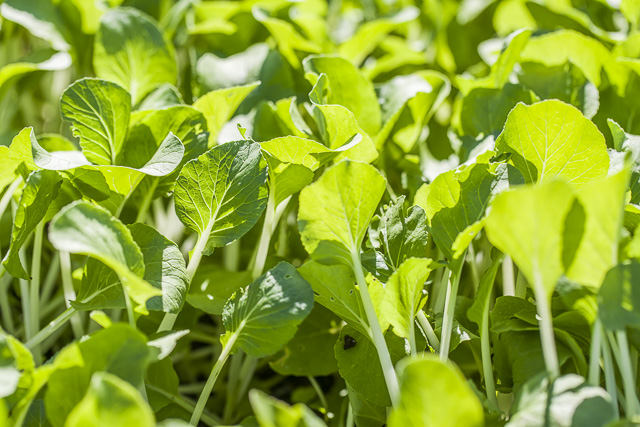 Bok choy ready to go in the fields. Photo by Scott David Gordon
Bok choy ready to go in the fields. Photo by Scott David Gordon
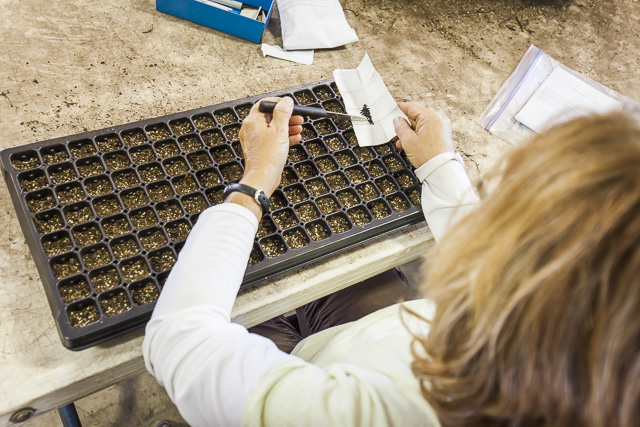 A volunteer seeding at our Garfield farm. Photo by Scott David Gordon
A volunteer seeding at our Garfield farm. Photo by Scott David Gordon
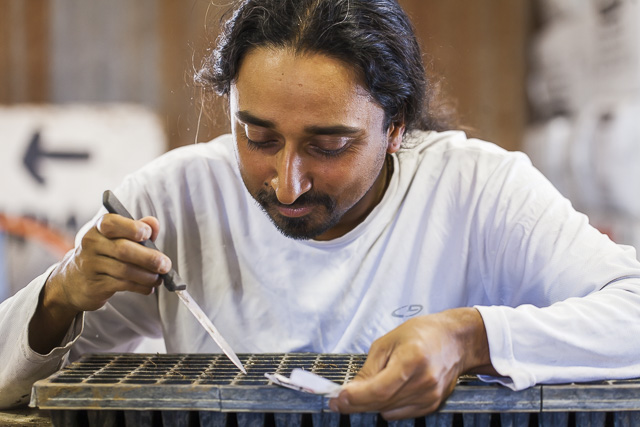 We're still offering volunteer spots in our greenhouses 7 days a week! Photo by Scott David Gordon
We're still offering volunteer spots in our greenhouses 7 days a week! Photo by Scott David Gordon
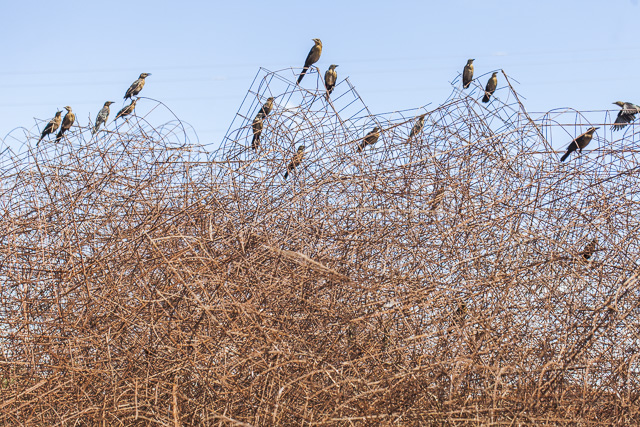 Birds watching us work from the pile of tomato cages. Photo by Scott David Gordon
Birds watching us work from the pile of tomato cages. Photo by Scott David Gordon
 Greenhouse Manager Brandon waters transplants outside our greenhouses. Photo by Scott David Gordon
Greenhouse Manager Brandon waters transplants outside our greenhouses. Photo by Scott David Gordon
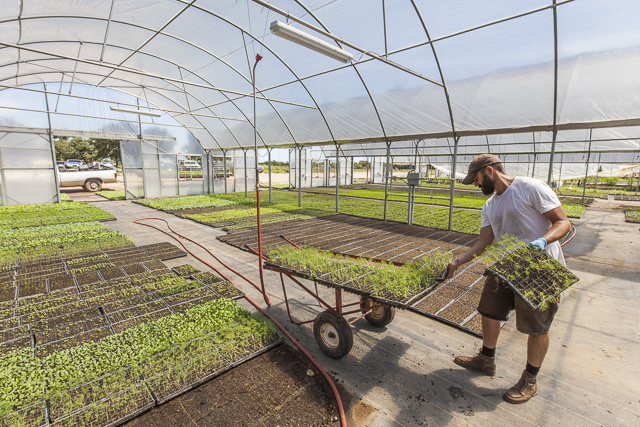 The greenhouses are especially full this time of year. Photo by Scott David Gordon
The greenhouses are especially full this time of year. Photo by Scott David Gordon
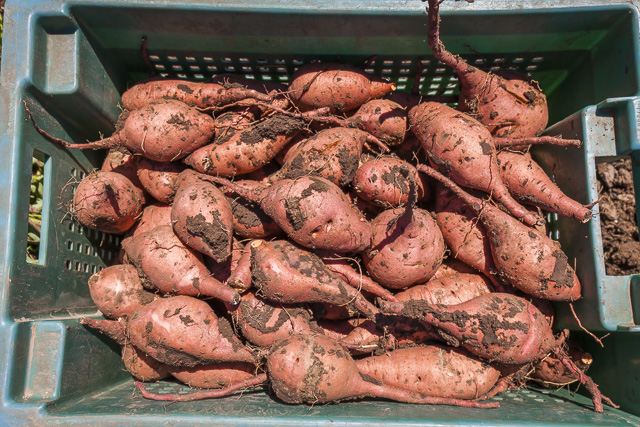 Sweet potatoes have started rolling in. Photo by Scott David Gordon
Sweet potatoes have started rolling in. Photo by Scott David Gordon
 We still have an abundance of summer crops like these banana peppers too. Photo by Scott David Gordon
We still have an abundance of summer crops like these banana peppers too. Photo by Scott David Gordon
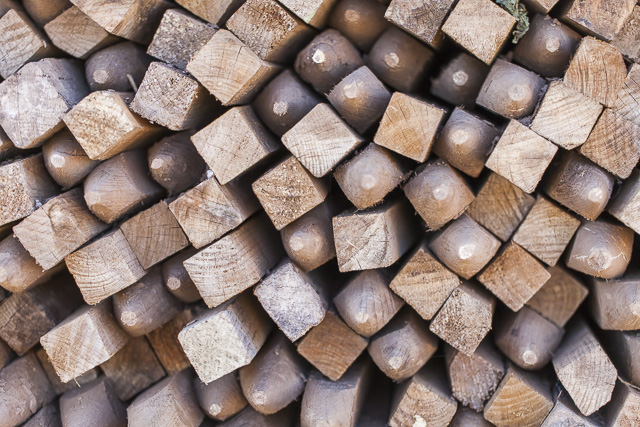 Tomato stakes coming out of the field really makes it feel like Fall around here. Photo by Scott David Gordon
Tomato stakes coming out of the field really makes it feel like Fall around here. Photo by Scott David Gordon
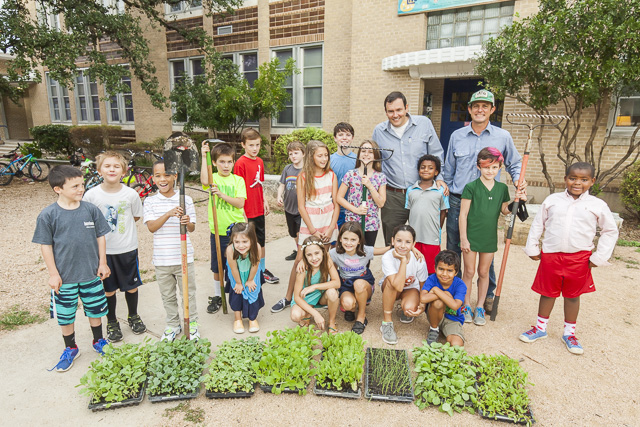 Brenton went to Lee Elementary to help the kids put in their fall gardens this week. Photo by Scott David Gordon
Brenton went to Lee Elementary to help the kids put in their fall gardens this week. Photo by Scott David GordonPRINCIPAL HEWLETT WEIGHS IN ON FARM-TO-SCHOOL
09/18/15 — Farm
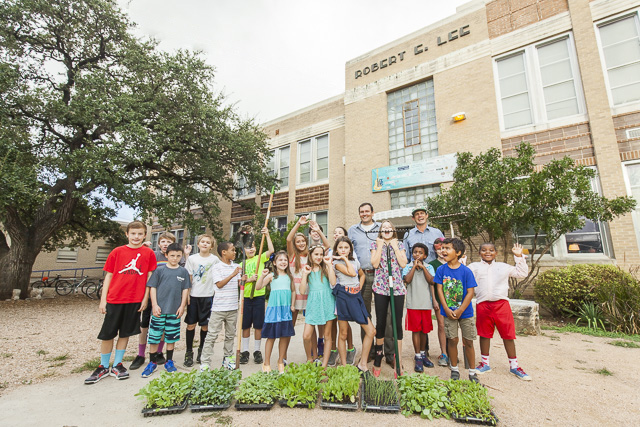 We planted the garden at Lee Elementary this week. Photo by Scott David Gordon
We planted the garden at Lee Elementary this week. Photo by Scott David Gordon
It's the beginning of the school year for many Texas families this month. Our kids are slowly switching gears and getting their heads back in the classroom, and getting used to not spending quite as much time outside as they did over the summer. However I had a fun excuse yesterday to get a few kids outdoors to learn a little bit about growing vegetables at their school, and I had a lot of fun!
Thursday morning, I went to Lee Elementary School where my kids Drew, Ada, and Jimmy attend, to get the students out of the classroom to plant their school garden for the fall! It was great to spend the morning outside with the kids, and I think they really enjoyed it too! While JBG isn't in the business of building or maintaining school gardens (there are a LOT of great Austin organizations helping our community with this), when Principal John Hewlett approached me and asked if I would lend a hand, I knew that it would be a fun opportunity.
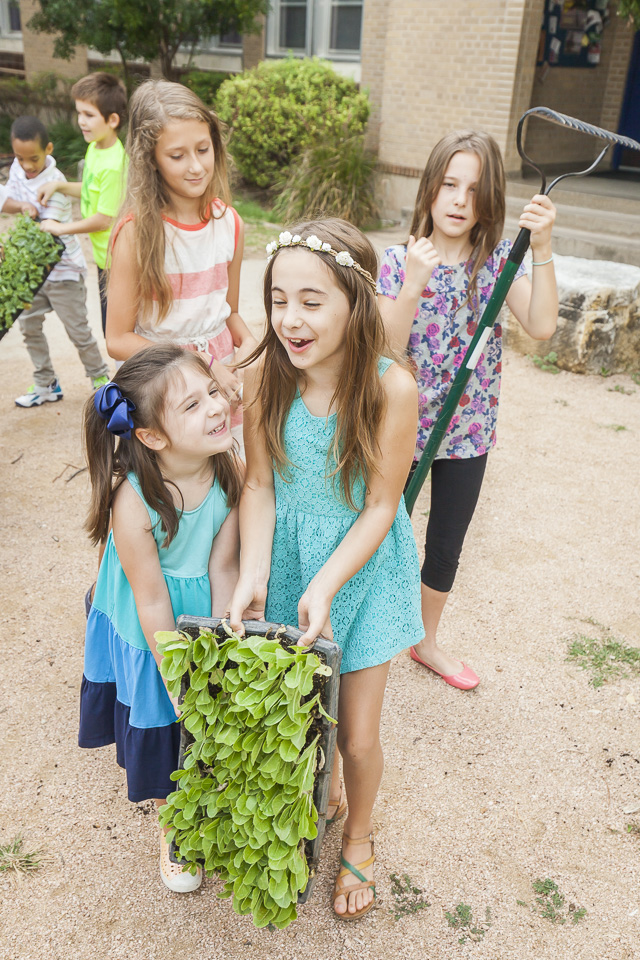 Excited gardeners. Photo by Scott David Gordon
Excited gardeners. Photo by Scott David Gordon
We also got to hear from Principal Hewlett about farm-to-school programs and how he's getting Lee Elementary involved! Farm-to-school programs vary greatly in size and scope, and alongside school gardens they are a great way to connect our kids to growing their own food, and encourage healthier choices in the lunchroom. We were excited to announce last week that JBG is now an AISD approved vendor, and we are definitely looking forward to bring farm-fresh veggies into the lunchroom this year. Principal Hewlett had some great thoughts on farm-to-school and I wanted to share some of them with you this week!
JBG: What's the state of farm-to-school programming in Austin?
JH: There's been a big shift lately within AISD, really trying to bring farms into the schools. In the past, there have definitely been elements of that, but the district has made some real gains in that area. The biggest one I've seen recently is a move towards inclusion of that food into our cafeterias. Now we are able, to my understanding, to request JBG produce in the cafeteria!
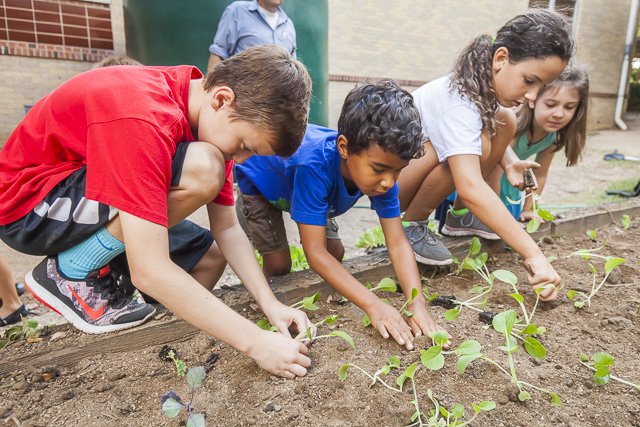 Planting bok choy. Photo by Scott David Gordon
Planting bok choy. Photo by Scott David Gordon
JBG: Has it been a difficult process to get to this point?
JH: Brenton approached me last year asking who to talk to about becoming a vendor within the school district. I honestly thought it was going to be a much longer process than it has been, which indicates to me that the district is really interested in doing this. I think it really comes from a desire within communities to have that food in schools - that's where it really starts.
JBG: What do you think makes farm-to-school programs important?
JH: There has been a really long-standing desire within our school community to improve the offerings in our cafeteria. We have lots of students who bring their own lunches, and are bringing fresh produce from home into school. To have that same level of nutrition offered in our cafeteria is something that the parents and the district have a big interest in. AISD leadership has been great when I've reached out - for example, Wendi Caudill, who oversees the cafeteria program, worked in conjunction with Lauren Hyatt, our cafeteria manager this year for a made-to-order salad bar! So, there have been these incremental changes, even just in my one year here at Lee, which have been really encouraging.
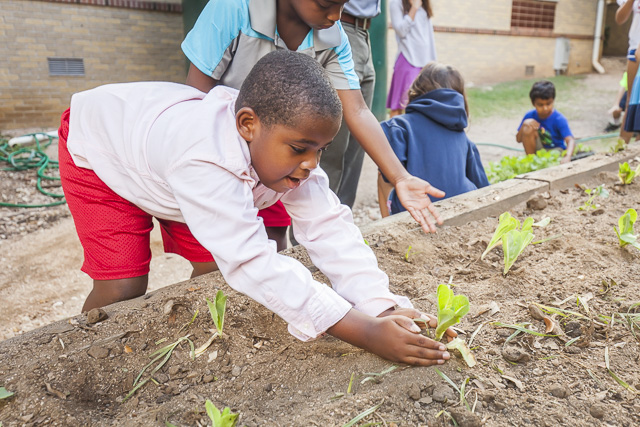 We also planted lots of romaine lettuce - maybe destined for Lee's salad bar! Photo by Scott David Gordon
We also planted lots of romaine lettuce - maybe destined for Lee's salad bar! Photo by Scott David Gordon
JBG: Have you encountered any obstacles in getting healthy, local foods into the cafeteria?
JH: I think everyone is interested in fresh healthy food for kids, but we definitely encounter challenges too - we continue to see that the most popular food is pizza, and other maybe not-so-healthy options. But I really love to order from our made-to-order salad bar, and I try to not order and leave, but sit with some of our kids and talk to them about the food, so they understand that it's there and available for them. It’s a paradigm shift for us and for them -- we aren’t necessarily used to seeing something like that in the cafeteria, but its a change that were really excited to see!
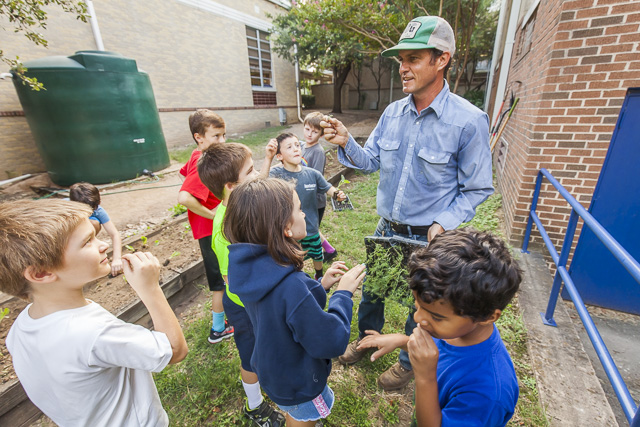 Photo by Scott David Gordon
Photo by Scott David Gordon
Principal Hewlett was full of praise for the parents in the Lee Elementary community. He has definitely noticed that parents are introducing their kids to local food outside the classroom, like bringing them to farmers markets, and so when they see the same local organic veggies in the cafeteria it's already a familiar concept to them! For example, I couldn't believe that some of the kids recognized Fennel and Chard from the transplants we put in the ground this week! Everyone was even really excited to taste test some new veggies when offered. In Principal Hewlett's words, "Out parents to a great job informing their kids about healthy choices outside of school." So thanks, parents, for helping us to raise the next generation to eat locally and organic, and please let us know how we can help support your farm-to-school programs too!
Got an idea for a fun way to bring JBG to your school? Selling CSA boxes door-to-door instead of candy for your next fundraiser? Buying local veggies from the farm for your next school event? We'd love to hear your ideas!
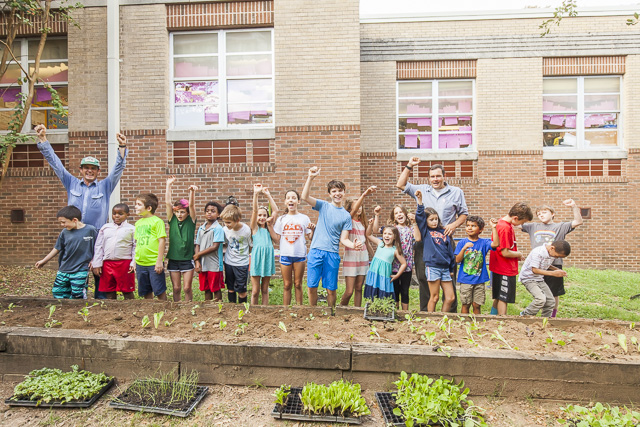 Thanks for having us, Lee Elementary! Photo by Scott David Gordon
Thanks for having us, Lee Elementary! Photo by Scott David GordonCSA BOX CONTENTS WEEK OF SEPT 21ST
09/21/15 — Scott
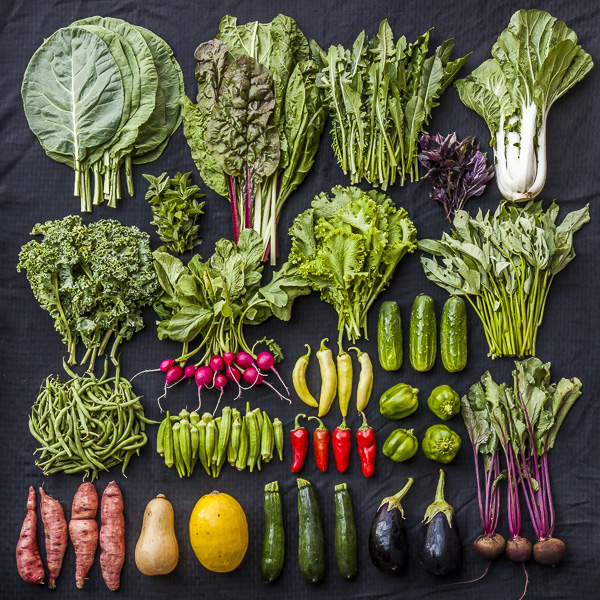
Bean, Green
Beet, Red
Cucumber, Pickling
Eggplant , Black
Greens, Chard, Rainbow
Greens, Collards
Greens, Mustard
Herb, Papalo
Kohlrabi, Purple
Pepper, Sweet Medley
Potato, Sweet
Squash, Butternut
Squash, Zucchini
Bean, Green
Beet, Red
Cucumber, Pickling
Eggplant , Black
Greens, Chard, Rainbow
Greens, Collards
Herb, Papalo
Okra
Pepper, Sweet Medley
Potato, Sweet
Bok Choy
Greens, Kale, Curly
Okra
Pepper, Sweet Medley
Squash, Butternut
Squash, Zucchini
Turnip, White Japanese
Bok Choy
Pepper, Sweet Medley
Potato, Sweet
Radish, Red
Squash, Butternut
MEXICAN SWEET POTATO STUFFED BELL PEPPERS
09/22/15 — Farm

By Megan Winfrey
A couple of nights a week, I find myself making vegetarian meals, even though my husband and I are meat eaters. Most days, it's honestly because I forgot to take meat out of the freezer.... You see, my husband really really likes meat in his meals, ( he was raised on steak and taters ) but with such bounty from our CSA box, I've been able to make super satisfying vegetarian meals that satisfy my carnivorous hubby. Stuffed peppers are one of our go-tos, and we both thought this week's were exceptionally good.
I served rice, and braised JBG greens with garlic and a splash of apple cider vinegar on the side. I will definitely be repeating this exact meal very soon!
Mexican Sweet Potato Stuffed Bell Peppers
- 2 sweet potatoes, peeled and roughly chopped
- 4 small bell peppers
- 1 small onion, diced
- 3 cloves of garlic, minced
- 1 tsp. cumin
- 1/2 tsp. cayenne pepper
- salt and pepper
- olive oil
- 3/4 cup mozzarella or Mexican blend cheese, shredded
Heat oven to 400ºF.
Bring a large pot of water to a boil. Drop in the sweet potatoes and boil until tender, about 10 minutes. Drain and set aside in a medium sized bowl.
Heat a bit of olive oil in a skillet over medium heat. Sauté the onions for 3-4 minutes, add garlic and sauté for another minute or two. Remove from heat and add to the sweet potatoes. Add the cumin and cayenne pepper and mash everything together. Keep the consistency chunky if you like, or mash until smooth. Salt and pepper to taste.
Half the bell peppers length-wise and hollow out the seeds. Arrange bowl side up in a baking dish and fill each one with the sweet potato mixture.

Cover the baking dish with foil and bake for about 30 minutes, until the peppers are tender. Remove the foil and top each pepper with a little shredded cheese. Leave uncovered and bake for another 5 minutes, then serve.
CSA BOX CONTENTS WEEK OF SEPT 21ST
09/22/15 — Scott
 CSA Box Contents Week of Sept 22nd
CSA Box Contents Week of Sept 22nd
Medium Box
Bok Choy
Eggplant , Black
Greens, Chard, Rainbow
Greens, Kale, Curly
Herb, Spearmint
Okra
Pepper Bell, Green
Potato, Sweet
Squash, Butternut
Squash, Yellow
WEEK 39 IN PHOTOS
09/25/15 — Farm
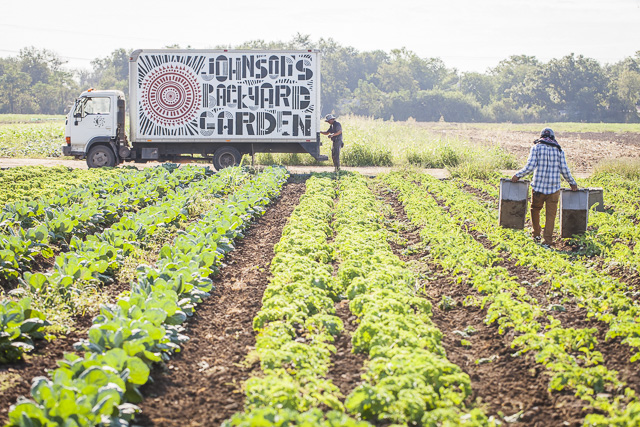 Harvest time. Photo by Scott David Gordon
Harvest time. Photo by Scott David Gordon
Everything is coming together at the farm for a great fall season. We're filling in the gaps in the field with lots of favorites - head lettuce, brassicas, carrots and beets, to name a few. With lots of new crops in the ground, we're also working hard to plot the course for our Harvest Hustle 5K race on October 24th, a great way to see where your food is grown first hand. Scott David Gordon made it out to capture sunrise on the farm this week, and it was a beautiful one. Enjoy!
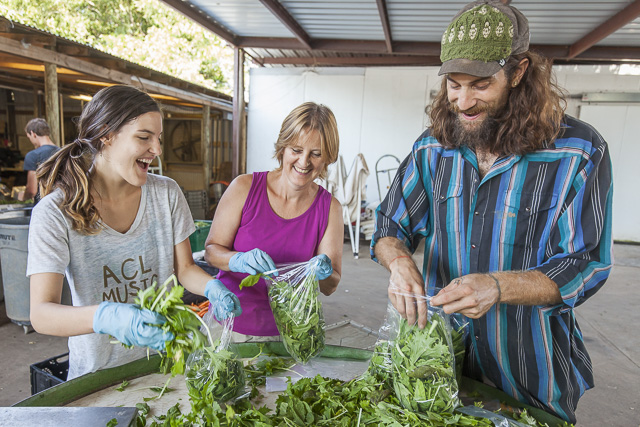 JBG staffer Andrew and volunteers having fun at our packing shed. Photo by Scott David Gordon
JBG staffer Andrew and volunteers having fun at our packing shed. Photo by Scott David Gordon
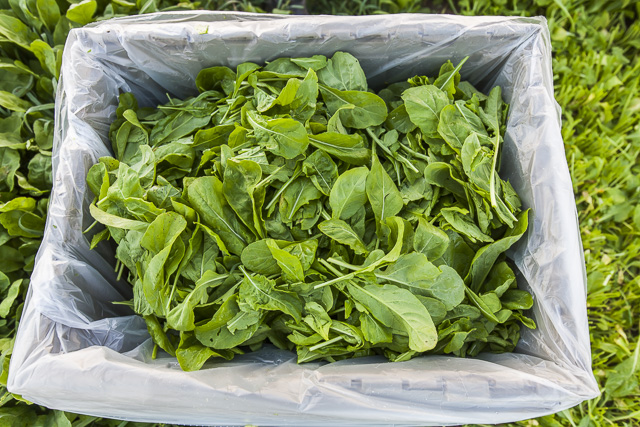 Peppery arugula is a favorite this time of year. Photo by Scott David Gordon
Peppery arugula is a favorite this time of year. Photo by Scott David Gordon
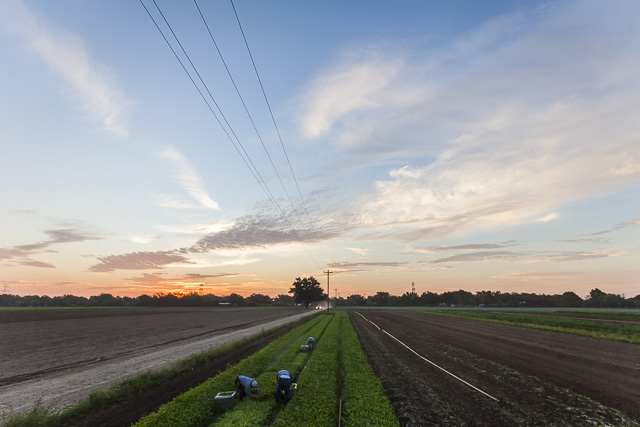 Scott captures a sunrise harvest at the farm. Photo by Scott David Gordon
Scott captures a sunrise harvest at the farm. Photo by Scott David Gordon
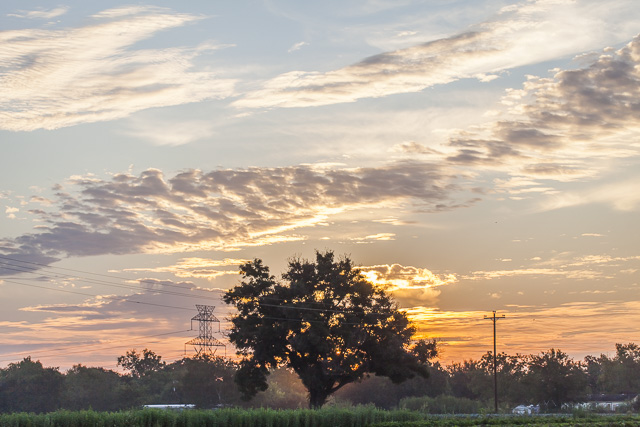 The big oak at sunrise. Photo by Scott David Gordon
The big oak at sunrise. Photo by Scott David Gordon
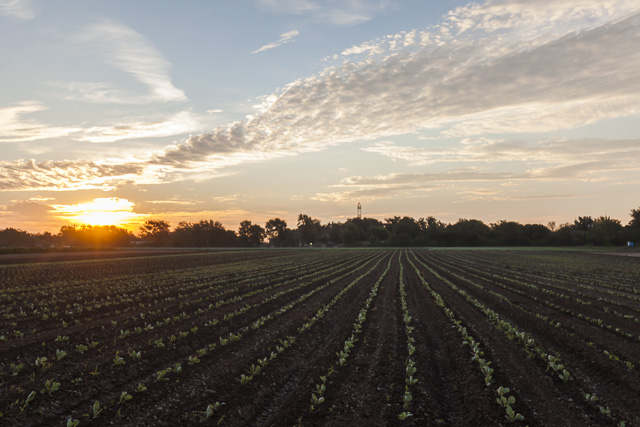 We're celebrating one year without plastic mulch! Photo by Scott David Gordon
We're celebrating one year without plastic mulch! Photo by Scott David Gordon
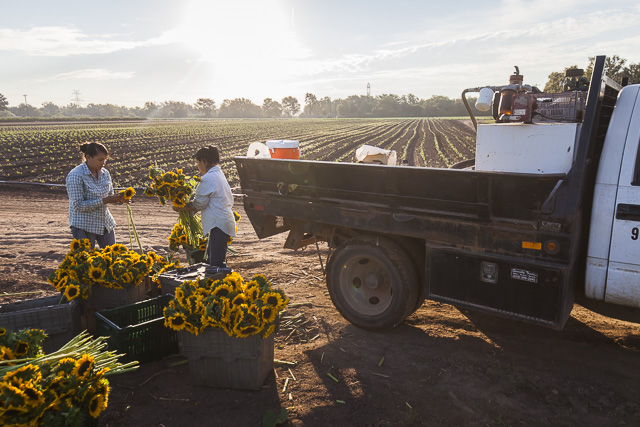 Bunching sunflowers. Photo by Scott David Gordon
Bunching sunflowers. Photo by Scott David Gordon
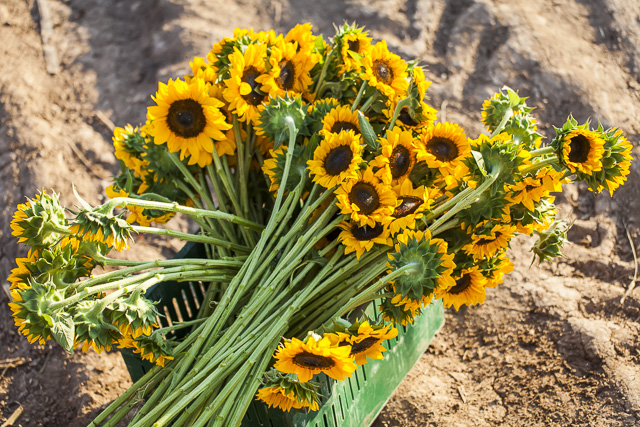 Photo by Scott David Gordon
Photo by Scott David Gordon
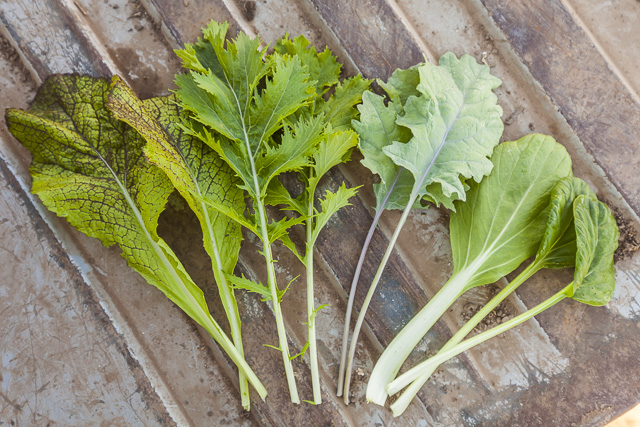 The makings of a great braising mix - from left to right: red mustard, mizuna, baby kale, bok choy, tatsoi. Photo by Scott David Gordon
The makings of a great braising mix - from left to right: red mustard, mizuna, baby kale, bok choy, tatsoi. Photo by Scott David Gordon
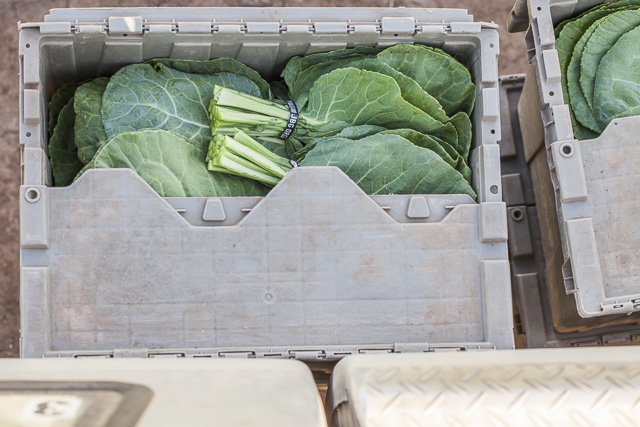 Collards peeking out of a harvest bin.
Collards peeking out of a harvest bin.
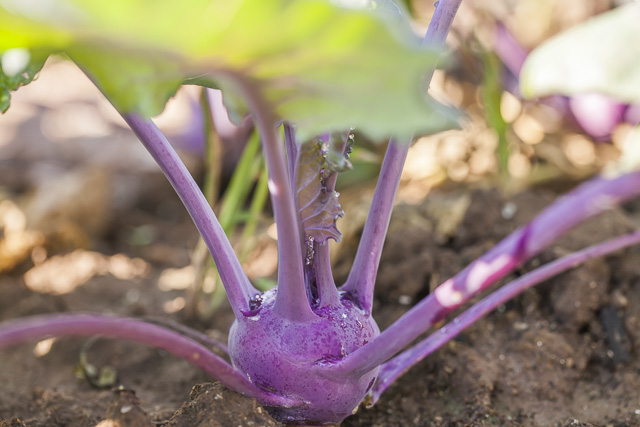 Our first kohlrabi is starting to make bulbs, be on the lookout soon at market! Photo by Scott David Gordon
Our first kohlrabi is starting to make bulbs, be on the lookout soon at market! Photo by Scott David Gordon
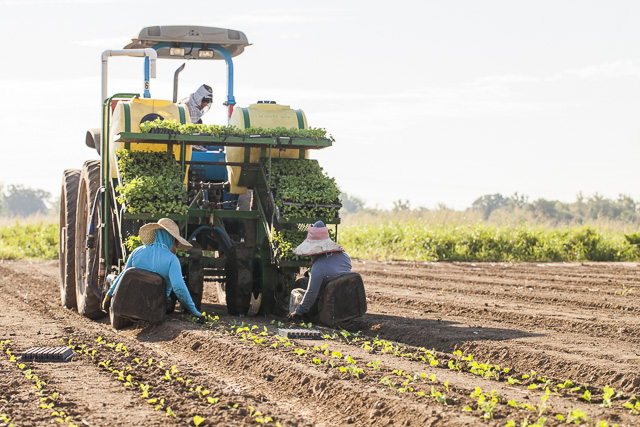 Transplanting lettuce. Photo by Scott David Gordon
Transplanting lettuce. Photo by Scott David Gordon
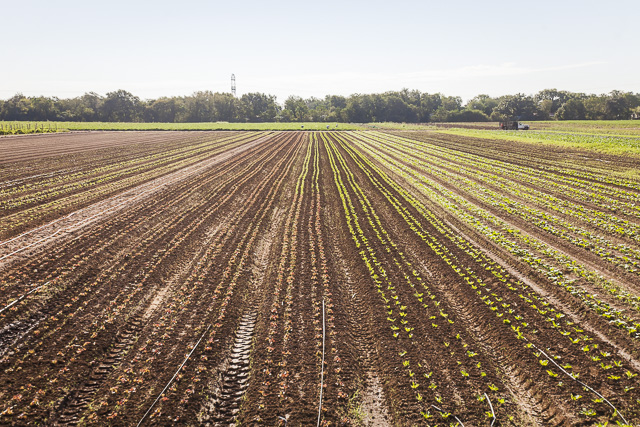 Fields of baby lettuce heads. Photo by Scott David Gordon
Fields of baby lettuce heads. Photo by Scott David Gordon
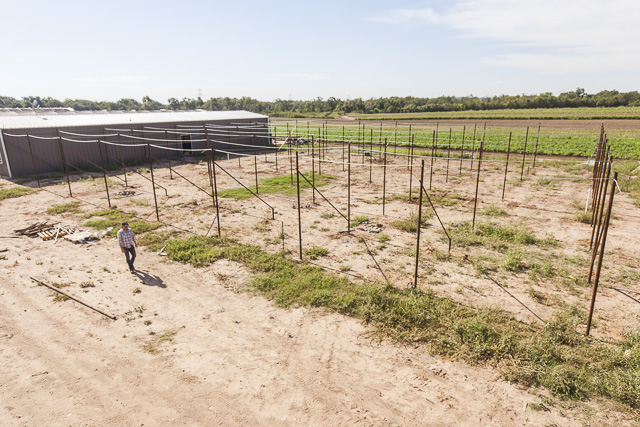 We're making progress on the new shade structure! Photo by Scott David Gordon
We're making progress on the new shade structure! Photo by Scott David GordonTICKETS NOW ON SALE - JBG HARVEST HUSTLE!
09/25/15 — Farm
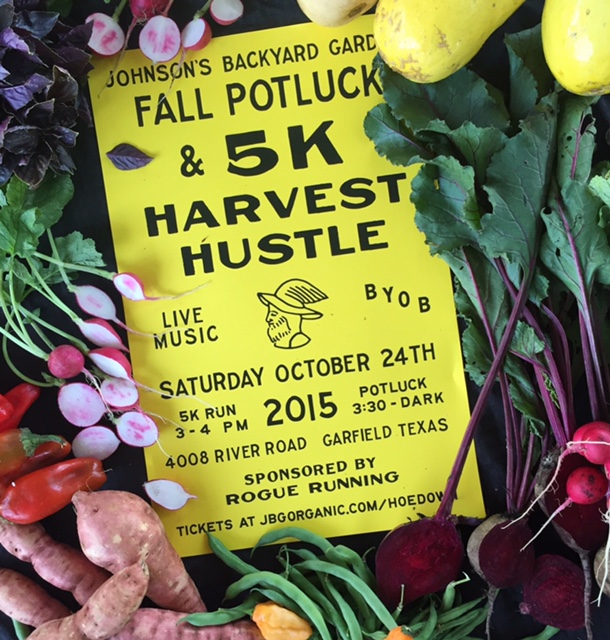
Buy your tickets for our Fall Potluck and Harvest Hustle here!
On Saturday, October 24th, join us and celebrate Autumn’s return with our annual Fall Potluck & 5K Harvest Hustle. These events will both be held at our Garfield Farm, 4008 River Road, Cedar Creek TX, 78612, located right along the beautiful Colorado River just east of ABIA.We will be kicking off the afternoon with our 5k Harvest Hustle and 1-mile Kids’ Fun Run around the farm. Rogue Running is sponsoring the race, and it will surely be top-notch! Expect to get a sneak peak of our fall crops as you weave your way through fields of brassicas, carrots, and more. This is a fantastic way to celebrate the season with friends and family, and experience first-hand where your food is grown!
 Photo by Scott David Gordon
Photo by Scott David Gordon
Less of a runner and more of an eater? We hope you’ll join us for our Fall Potluck meal after the Harvest Hustle. At this one-of-a-kind meal, guests are encouraged to bring a dish to share with their fellow locavores and farm-lovers. Please bring a dish; potluck participants will enjoy a discounted entrance ticket. This event is BYOB, so be sure to grab your favorite fall porter or sparkling cider and settle in.
Of course, we’re bringing in several outstanding musicians to help set the mood for this harvest celebration. Carson McHone and her band, The Bottom Dollar String Band, and one other act (TBA) will make sure to provide lively entertainment. In addition to our monster-sand pile, there will be arts and crafts for the kids (and plenty of fields to explore!). Proceeds from the Fall Potluck and Harvest Hustle will help support the local bands playing that afternoon, and help fund JBG's recycled tire playground. Fall one of the most beautiful seasons on the farm!
You can buy your tickets at jbgorganic.com/hoedown. See you on October 24th!
 Photo by Scott David Gordon
Photo by Scott David GordonFTFP: RISKY BUSINESS
09/25/15 — Farm
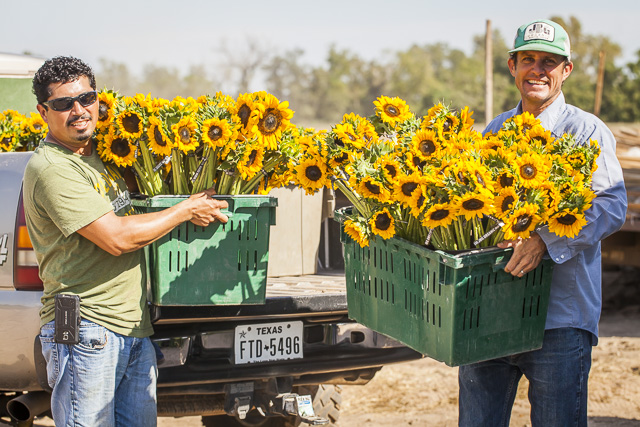 Vicente and Brenton pose with sunflowers destined for farmers market. Photo by Scott David Gordon
Vicente and Brenton pose with sunflowers destined for farmers market. Photo by Scott David Gordon
From the Farmer's Perspective: Risky Business
Driving into the farm this morning, I'm amazed to see the change of seasons manifesting in our fields; there are a million things going on these days! Today we harvested our first carrots of Fall and the cabbage along the main farm entry road is starting to head up, and it looks like we'll see the first of the broccoli in about two weeks, as well as our first dill. We've started harvesting all kinds of radishes - red, watermelon, and black Spanish, and the first beets are out of the fields also! The harvest crew has no shortage of work these days, especially since all of our sunflowers and all of our green beans have matured at the exact same time - these will both be bountiful at all weekend markets. In the greenhouse we are approaching the last big week of seeding for fall, and we would love your help volunteering any day in the next week - just email us at volunteer@jbgorganic.com to reserve your spot. In the fields, Montana has been seeding lots of cover crop this week, a mix of fava beans, oats, and peas to add nitrogen and green matter to our soils. Also, I am planning to try some new Asian greens on the farm this fall, with fun names like mibuna, choi-sum, and hon-tsai ta, and this week we hope to get the first seeding of these new crops in the ground.
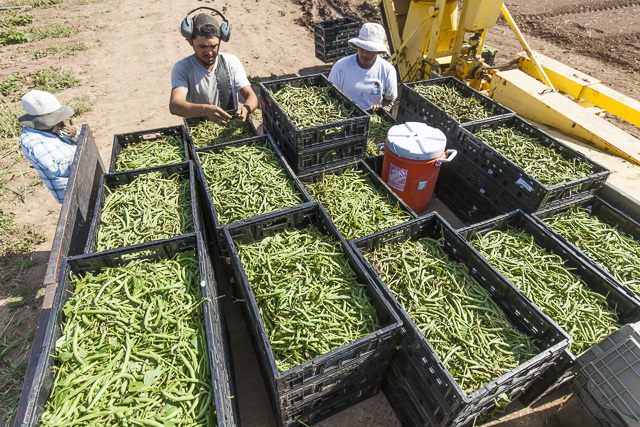 We've got loads of green beans headed to market this weekend! Photo by Scott David Gordon
We've got loads of green beans headed to market this weekend! Photo by Scott David Gordon
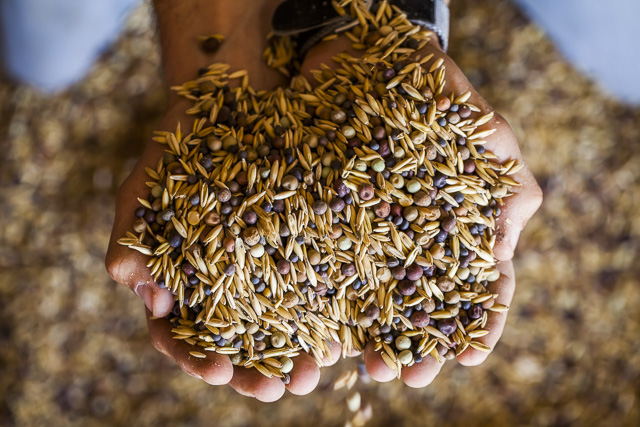 Cover crop seeds. Photo by Scott David Gordon
Cover crop seeds. Photo by Scott David Gordon
Fall is a little bit different every year, and with the "official" change of season this week, I've been reflecting on a few big risks we've taken at JBG, which have shaped the way that the fields look right now. The first is marked by an anniversary - this week, we celebrate one year without plastic mulch at JBG, an accomplishment I am very proud of. While plastic mulch has a number of benefits for farmers - weed control and water conservation for example - I hated the amount of waste we were producing on the farm using all of that non-recyclable plastic! Although my staff was on board with my decision to curb our waste, it has been a bumpy road readjusting our growing practices, and we've seen both positive and negative consequences from this decision.
The first and biggest plus, is that we've reduced our plastic waste by over half over the last year and kept a lot of rolls of this stuff out of the landfill. We're also spending much less time cleaning up our fields after the crop is harvested, since now we don't have to pick out pesky pieces of plastic from the soil before turning the field under. On the other hand, our labor costs have increased significantly - we've had to hire a 5 person crew nearly full time, year-round just to hand-weed beds, which costs a lot of money! We were also really surprised to see the effect that the heavy rains this year had on our bare ground crops. One important benefit that we did not realize until this year is that plastic sheds the rainwater from our beds, thus keeping our organic soils and amendments from being leached away by the rain. The extraordinary heavy rains we had this year resulted in a lot of material being washed away, so many of our crops suffered from reduced yields and smaller fruits in the spring and early summer.
It's been a year full of learning for us, and I'm grateful for the team at JBG for sticking with it and keeping the farm running with all of the changes. Moving forward, I feel that we made the right choice and will continue to grow at the Garfield farm without plastic mulch, learning even more as we move into our second year.
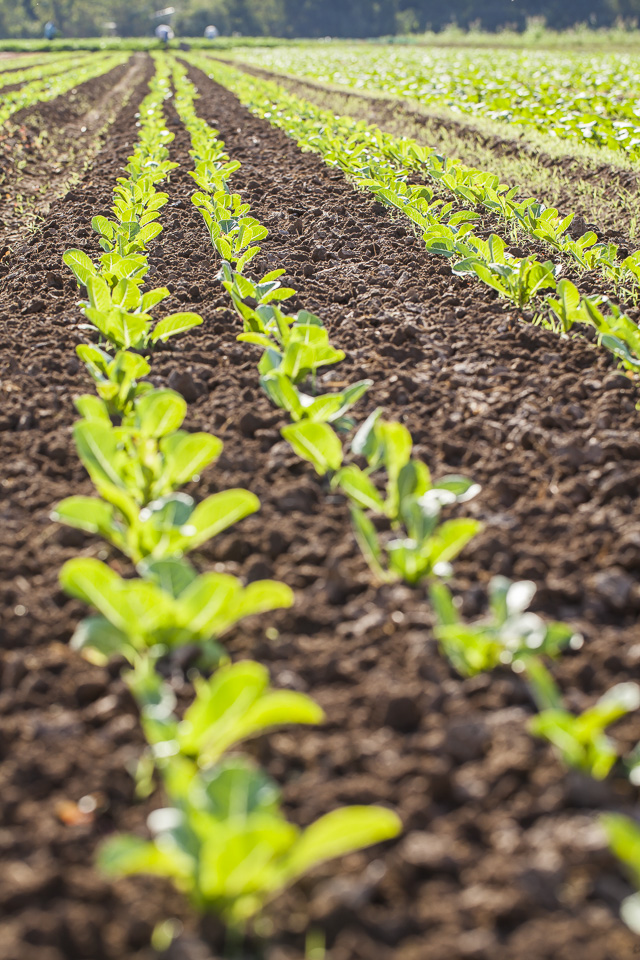 We're celebrating one year without plastic mulch! Photo by Scott David Gordon
We're celebrating one year without plastic mulch! Photo by Scott David Gordon
The second risky plan was a little more recent. After the floods in May and June, we were left with a farm full of potentially compromised fields. This year was the worst harvest of tomatoes we've ever seen, and pests have been putting heavy pressure on all of our crops left and right. While we worked our hardest to take care of the plants, my worry was that when the end of summer rolled around and the heat of late August and September set in, we might not have a great variety of crops for our customers. This just wasn't an option for us. We take great pride in providing for our year-round CSA program, and providing a healthy variety each week. This has been a mainstay of the farm since the beginnings in the backyard garden and I didn't want to let CSA customers down! So, when I saw a potential problem, we decided to take a risk and put in some fall crops much earlier than in most years. I wasn't sure how these early plantings would go - the summer heat is not always kind to leafy green crops - but I'm surprised and relieved to say that it was a great success. I don't like to gamble in Vegas, but I really do enjoy the gamble of farming!
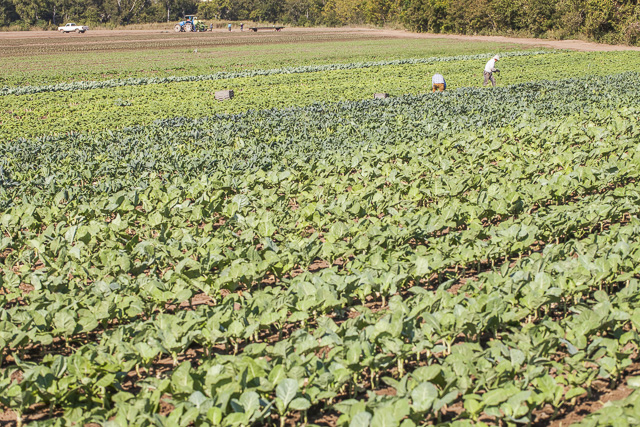 Fields of early Fall greens are looking great. Photo by Scott David Gordon
Fields of early Fall greens are looking great. Photo by Scott David Gordon
Hopefully, you've been enjoying your summer veggies alongside greens like bok choy, kale, and chard for the last few weeks- a result of this somewhat risky chance we took this summer. It's always a little scary taking a gamble like this, and while it doesn't always work, it tends to produce great results when it does! Farming is a profession that requires a lot of hope, and I think Will Rogers said it best - "A farmer has to be an optimist, or he wouldn't still be a farmer."
Interested in joining our CSA? We have two weeks left of a great promotion - first box free for all new customers! Just enter the code VEGNOW at checkout, and start getting deliveries of those tasty summer peppers, cukes, and squash in alongside your early fall greens this year.
For more of the farmer’s perspective, follow Brenton on Facebook, Twitter, or Instagram @farmerbrenton.
CSA BOX CONTENTS WEEK OF SEPT 28TH
09/28/15 — Scott
 CSA Box Contents Week of Sept 28th
CSA Box Contents Week of Sept 28th
Beet, Red
Bok Choy
Broccoli
Cabbage, Green
Carrot, Orange
Eggplant , Black
Greens, Collards
Greens, Dandelion
Herb, Cilantro
Okra
Pepper, Sweet Medley
Potato, Sweet
Squash, Zucchini
Beet, Red
Bok Choy
Eggplant , Black
Greens, Collards
Greens, Kale, Curly
Herb, Dill
Okra
Pepper, Sweet Medley
Potato, Sweet
Radish, Red
Carrot, Orange
Cucumber, Pickling
Eggplant , Black
Greens, Collards
Greens, Dandelion
Potato, Sweet
Turnip, White Japanese
Carrot, Orange
Cucumber, Pickling
Eggplant , Black
Greens, Dandelion
Greens, Kale, Curly
Okra
CSA BOX CONTENTS WEEK OF SEPT 28TH
09/29/15 — Scott
 CSA Box Contents Week of Sept 28th
CSA Box Contents Week of Sept 28th
Medium Box
Bean, Green
Beet, Red
Cucumber, Pickling
Eggplant , Black
Greens, Chard, Rainbow
Greens, Collards
Herb, Papalo
Okra
Pepper, Sweet Medley
Potato, Sweet
MRS. ELIE'S CREOLE GUMBO
09/29/15 — Farm
Wondering what to do with allllll of that okra that just keeps showing up in your CSA box? We're coming atcha with the best gumbo EVER this week!

This week, I took on a challenge that I've been shying away from for a few years. Gumbo, y'all. I have several friends that hail from Louisiana and they are all fabulous cooks - so I can confidently say that I've had some of the best gumbo out there. Now making it myself, not so confident about that one. But what better way to test yourself than in front of an audience, right? So here it is, my first attempt at gumbo, and I gotta say it was pretty damn good.
I used this recipe from the June 2012 issue of Smithsonian. It was the first link that came up when I googled "BEST GUMBO EVER"
- I modified it to better fit my time and budget. Here's how and why:
- I didn't use crab, too expensive
- I used headless shrimp, Whole Foods didn't have them with the heads on
- I used spicy pork sausage instead of Creole hot sausage, couldn't find it
- I served it over cornbread instead of rice, because I already had cornbread, and because yum
 Making roux.
Making roux.
I was most nervous about making the roux because I've never made one before and I've heard time and time again that it is the most important part of a good gumbo and it has to be PERFECT. Turns out, as long as you keep stirring, a roux will appear. Just as I was thinking that it was the perfect color, I began to really smell the flour cooking and took it off the heat. The milk chocolate-y color along with the nutty flour smell were strong indicators that the roux was done. Look out for those and you will be fine.
Now that I've made gumbo, I really don't know what I was so afraid of. When you think about it, it's a simple dish comprised of well-known ingredients. But my, oh my, when everything comes together over a hot stove in a kitchen full of love, it's slap-yo-mama-good. So 'tis the season for comfort food, family, and finding that classic recipe that will become your signature.
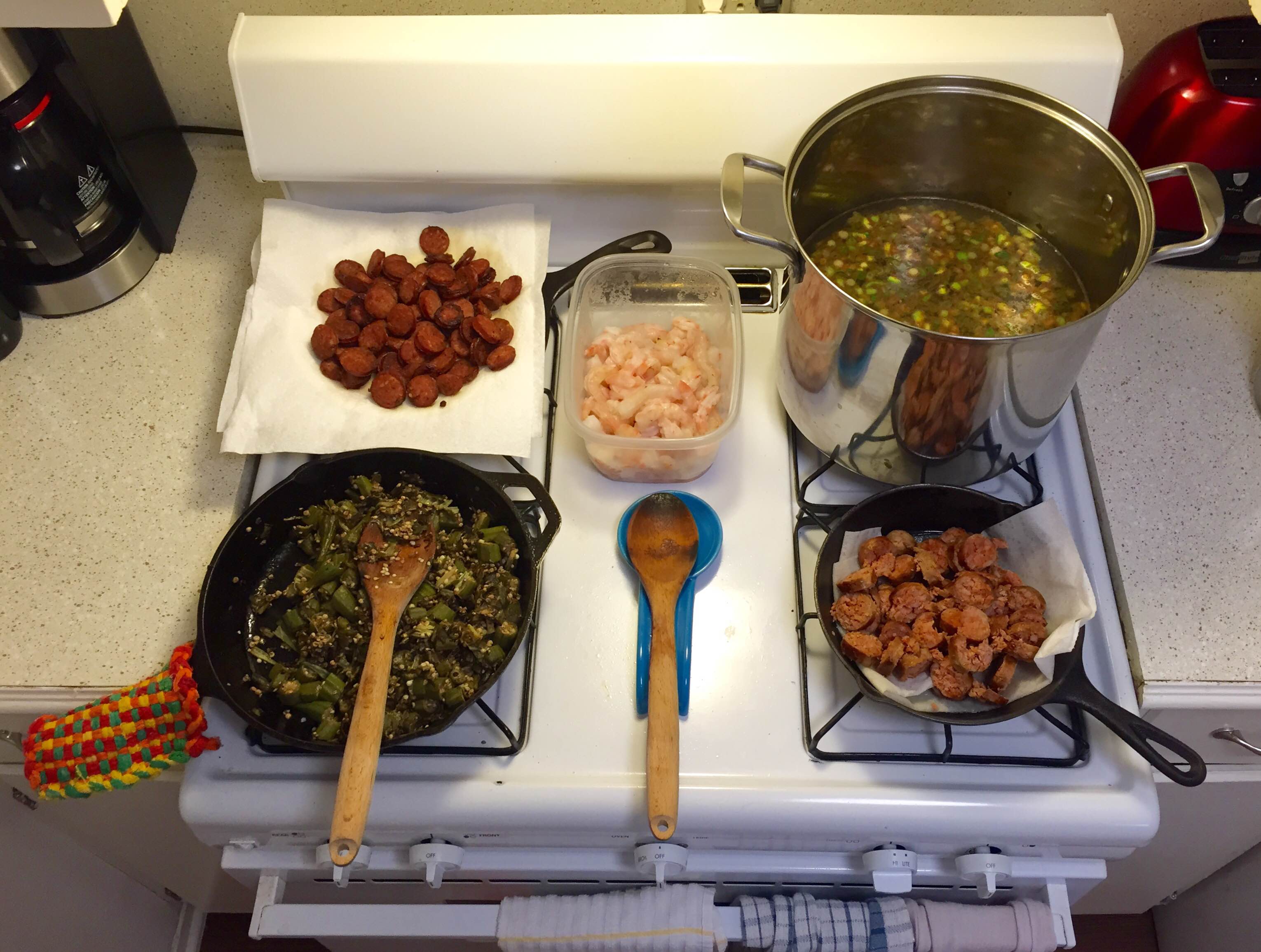






 0 ITEMS IN CART
0 ITEMS IN CART 


